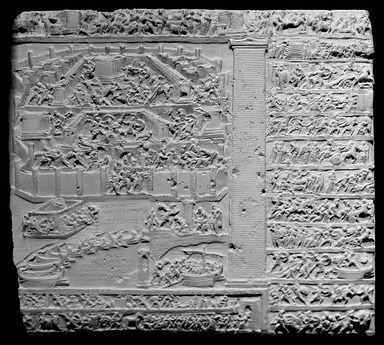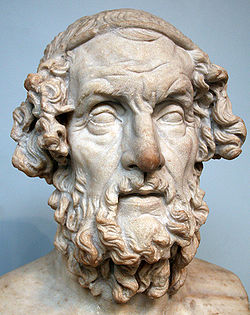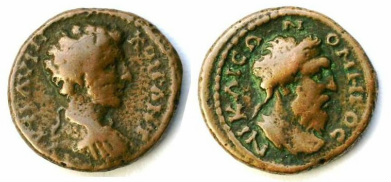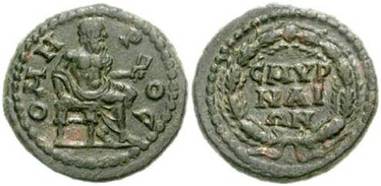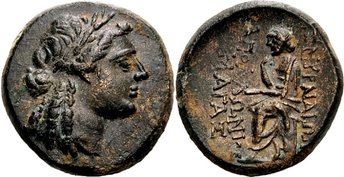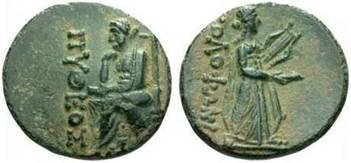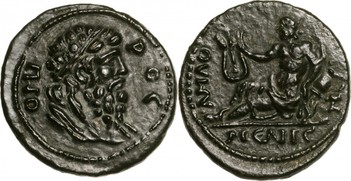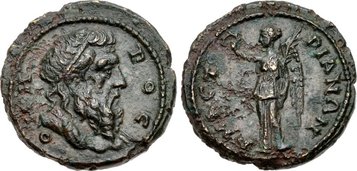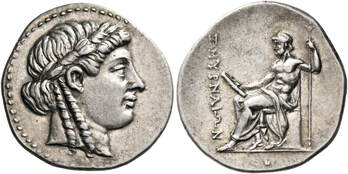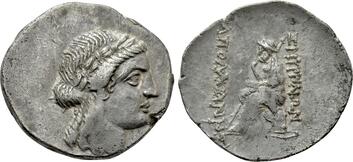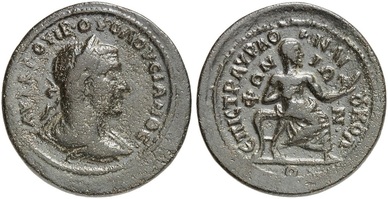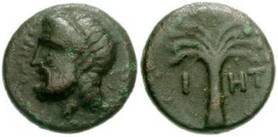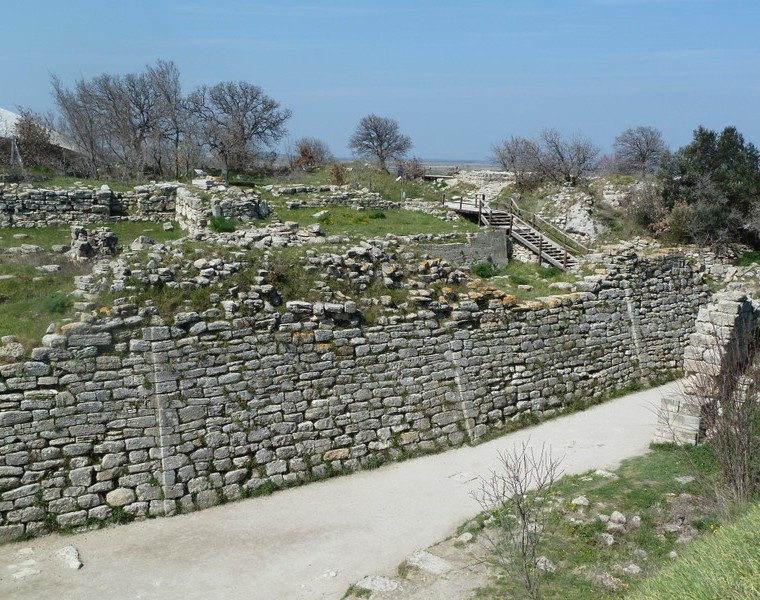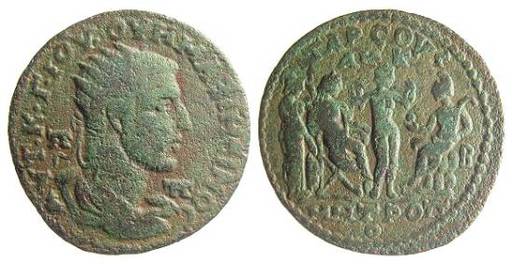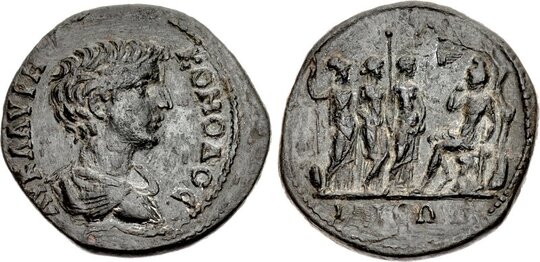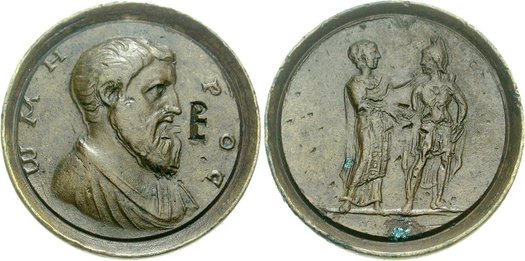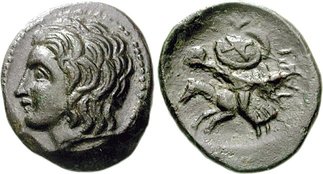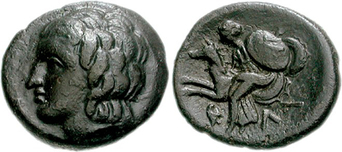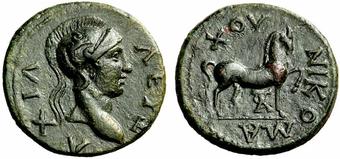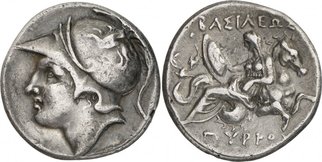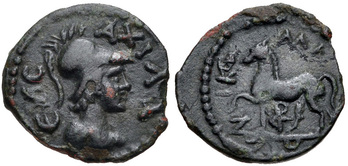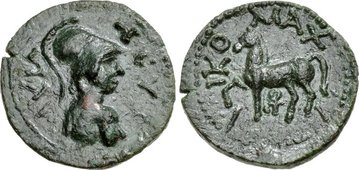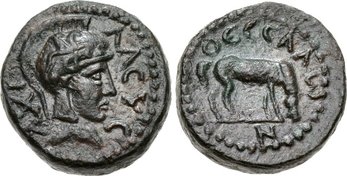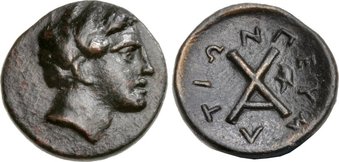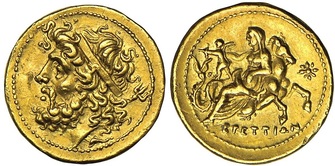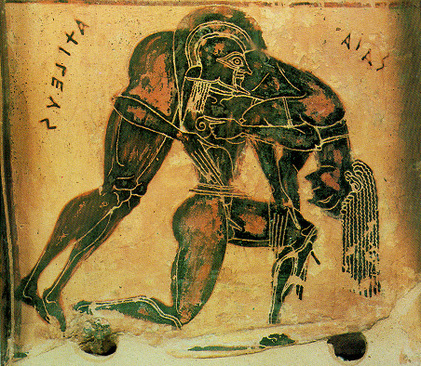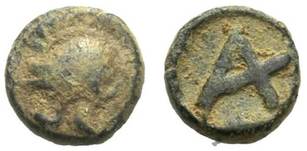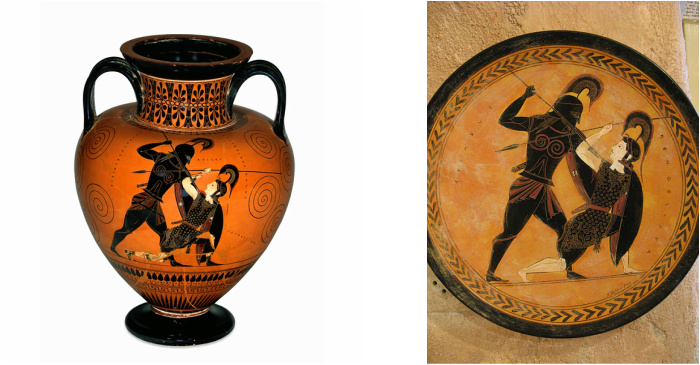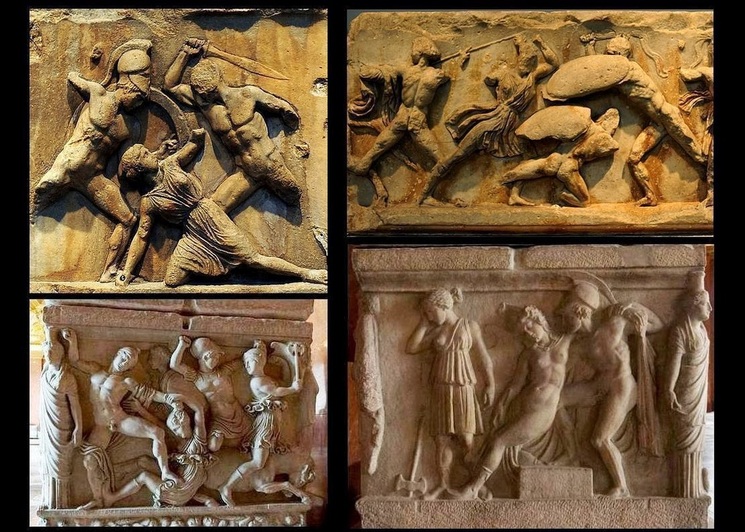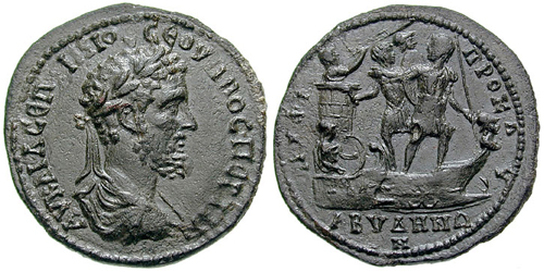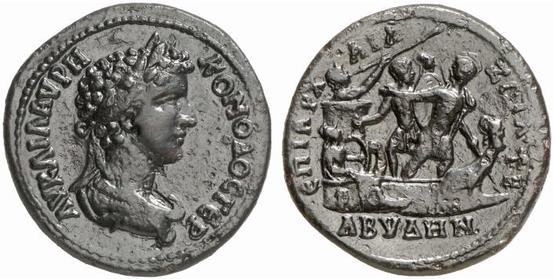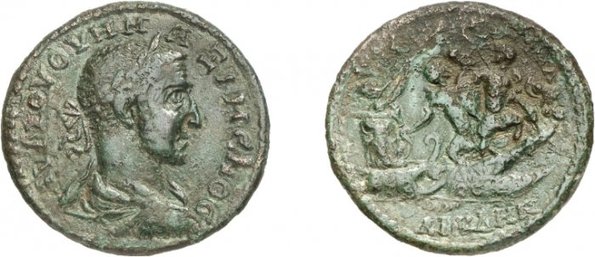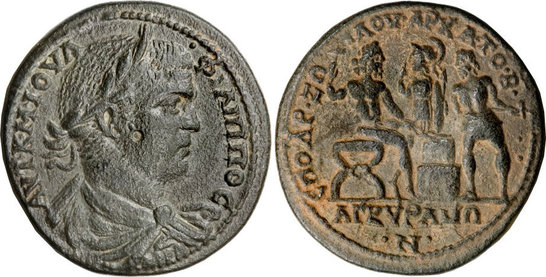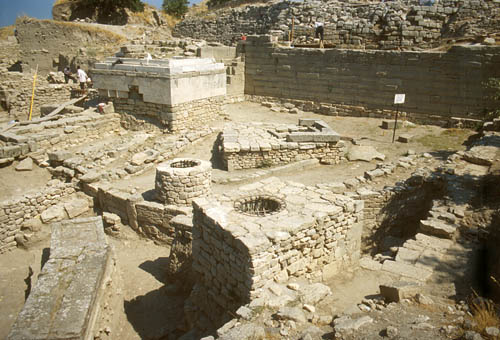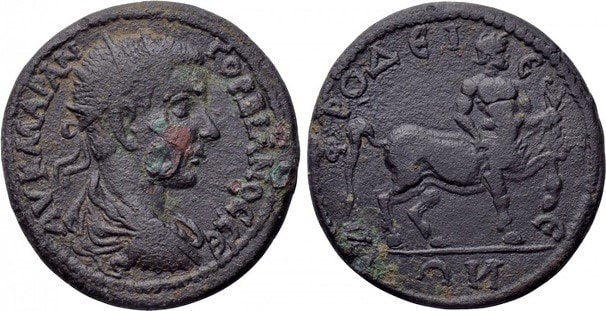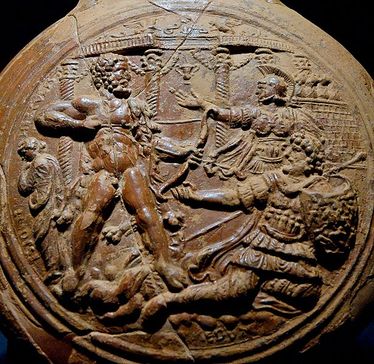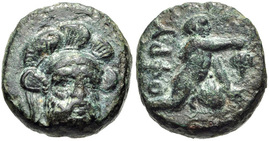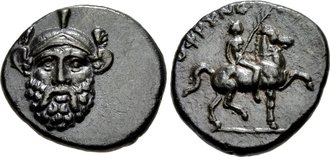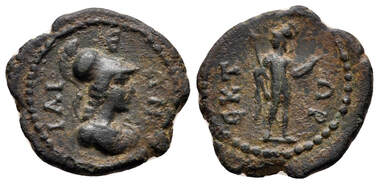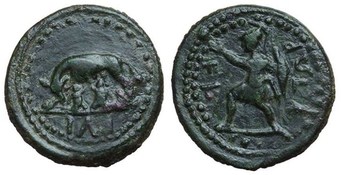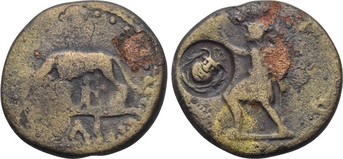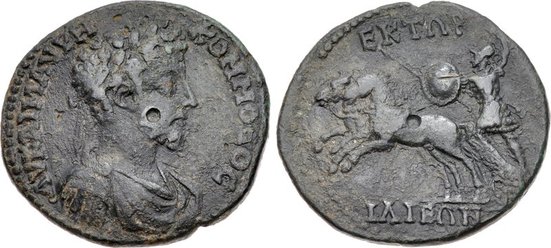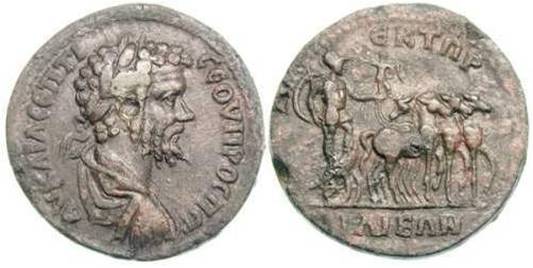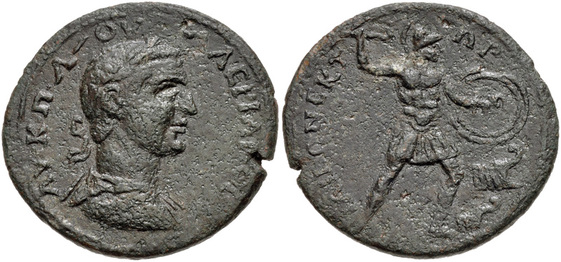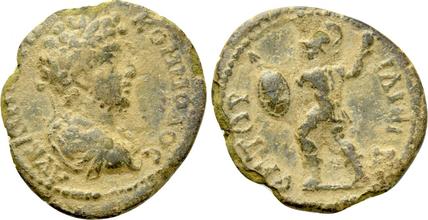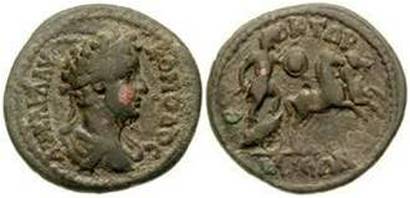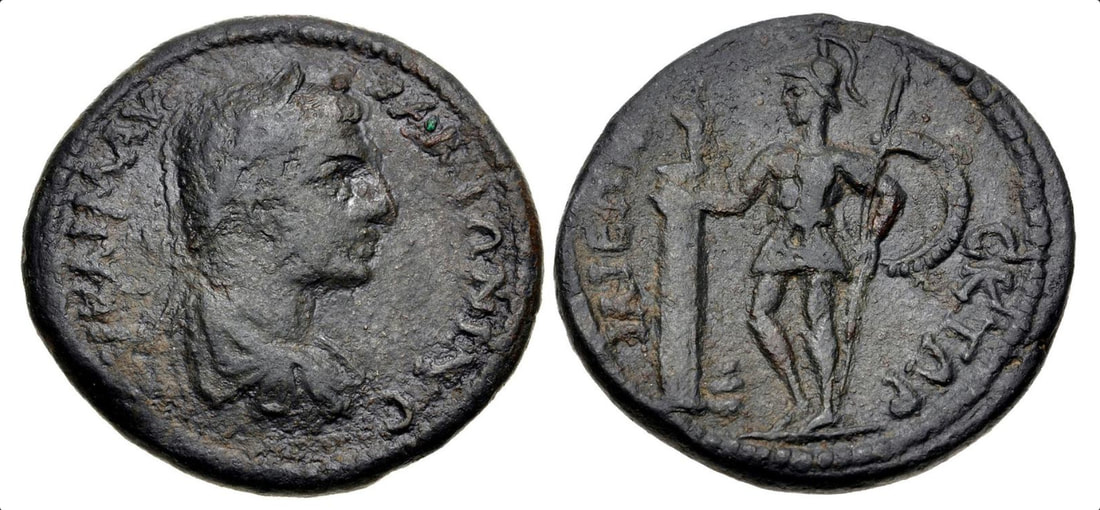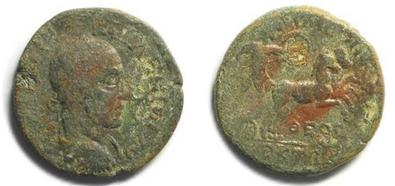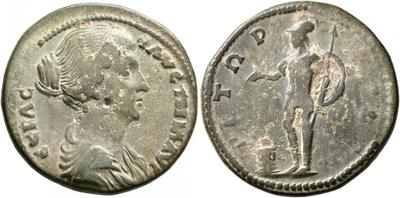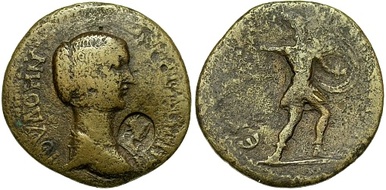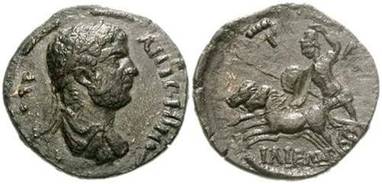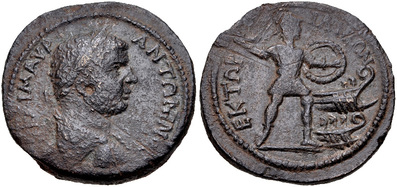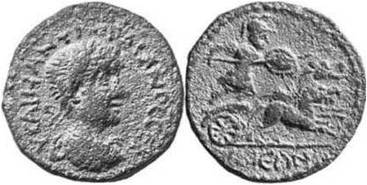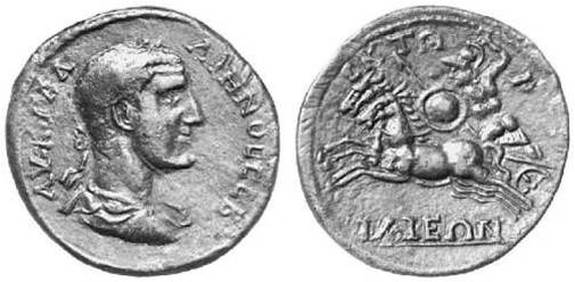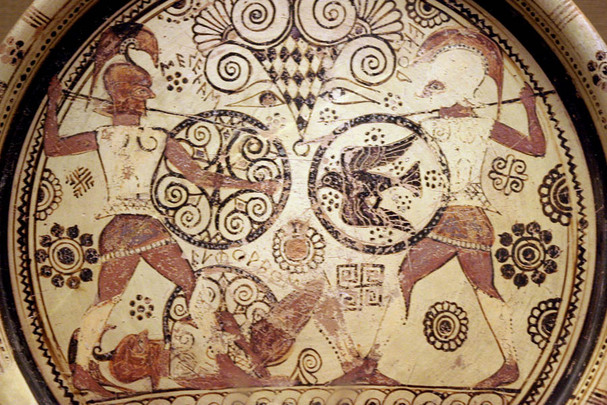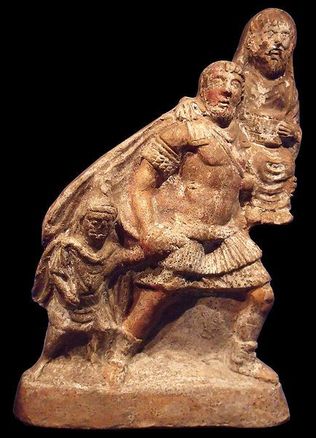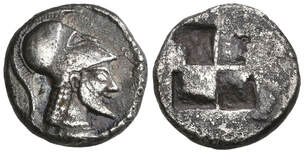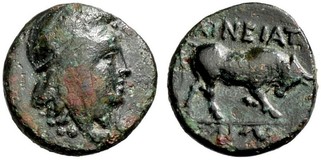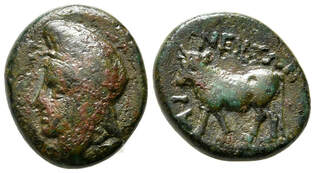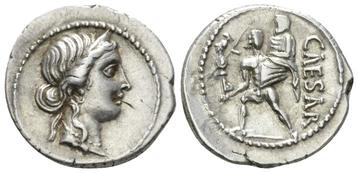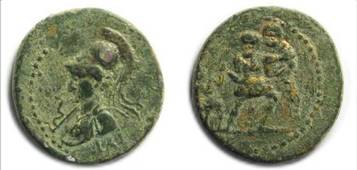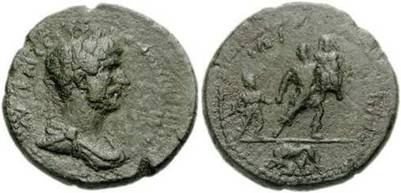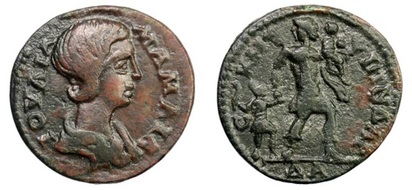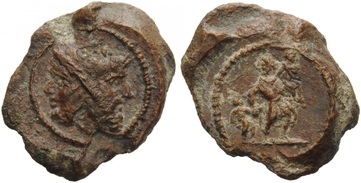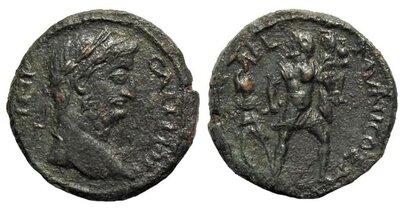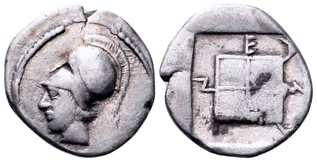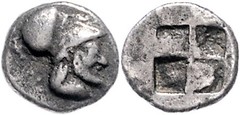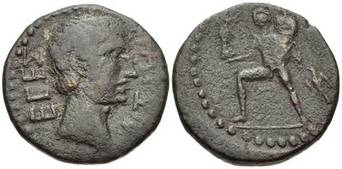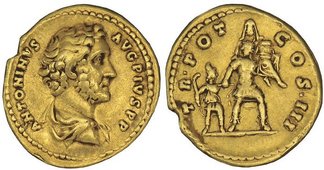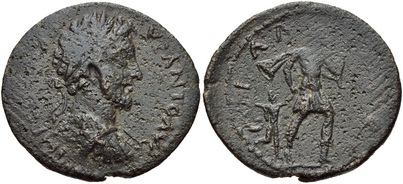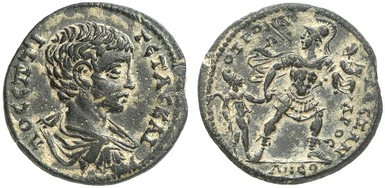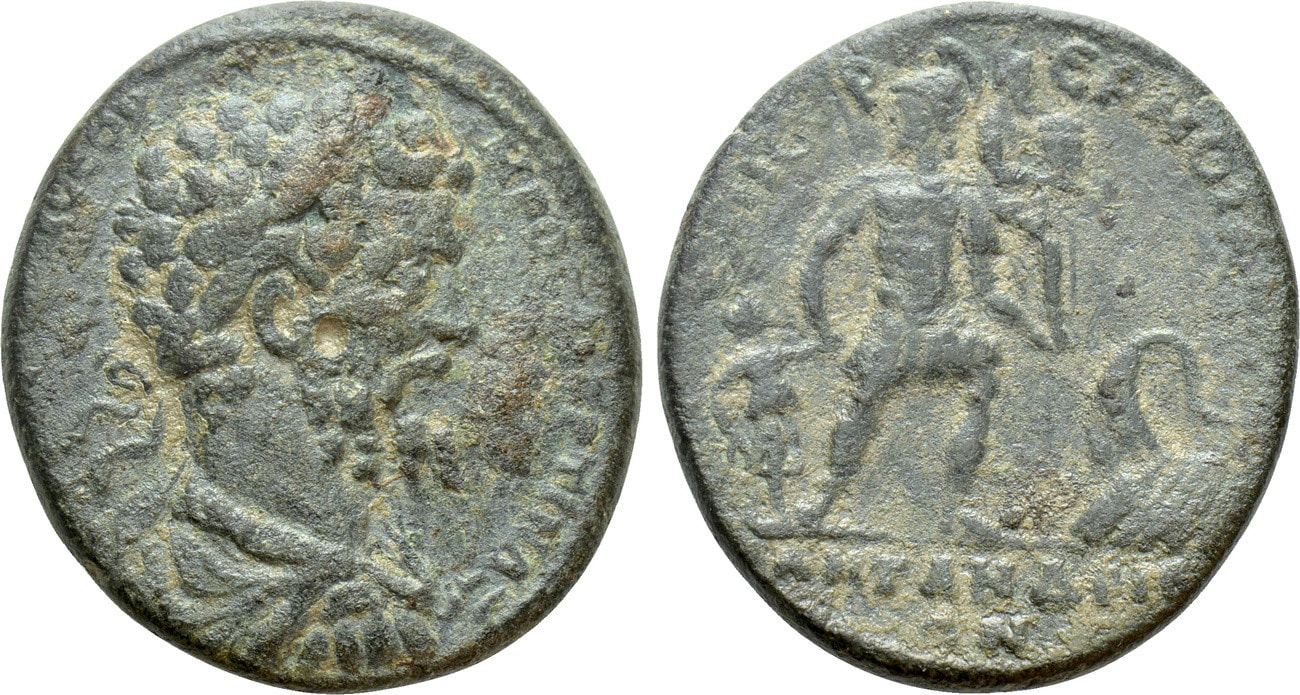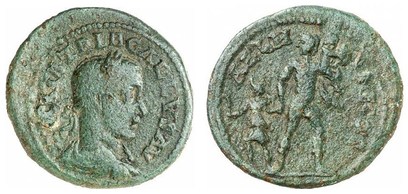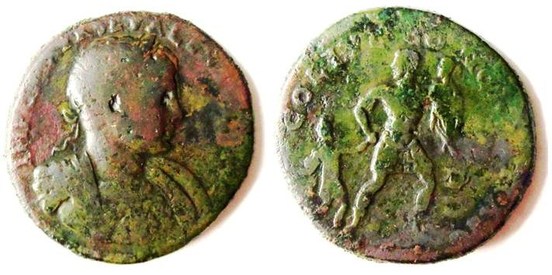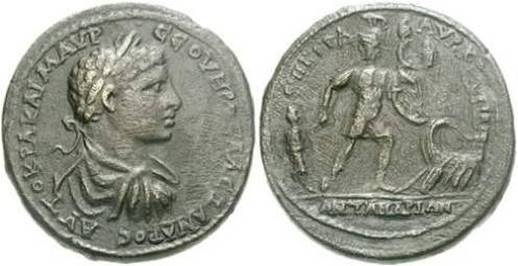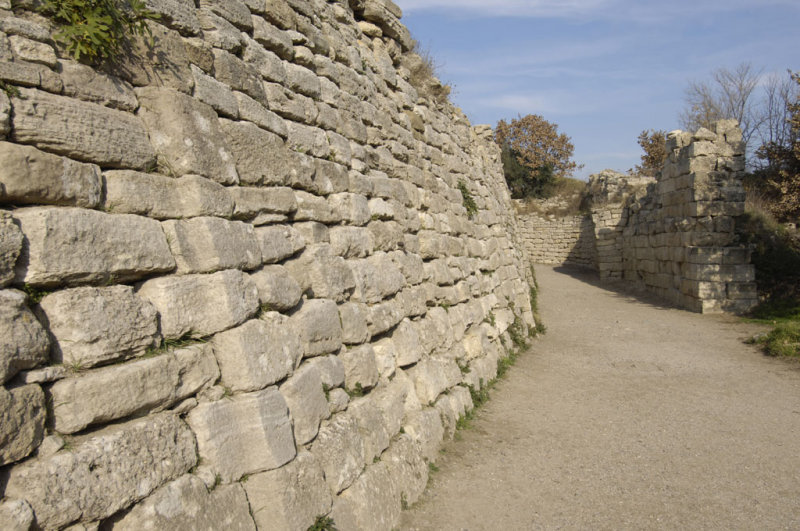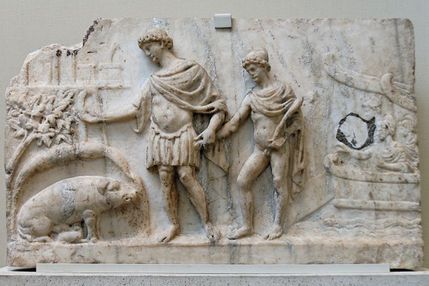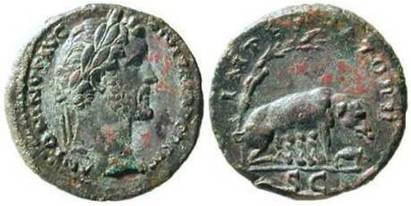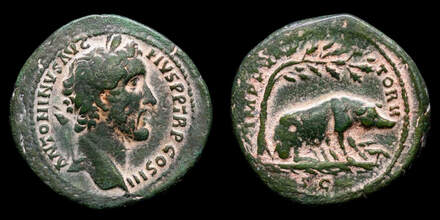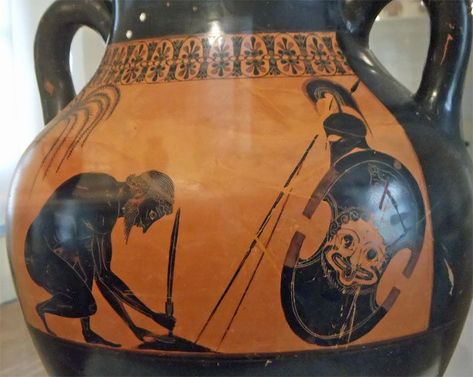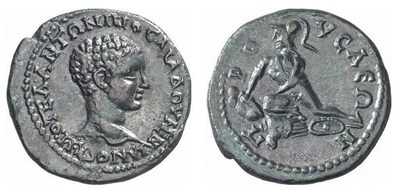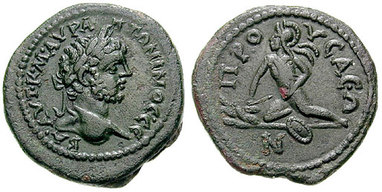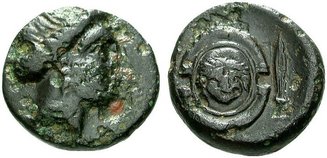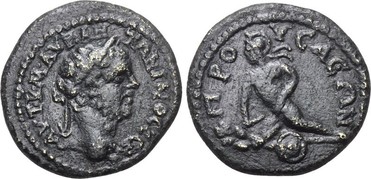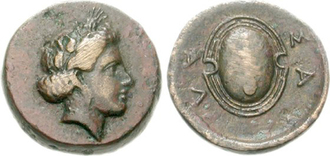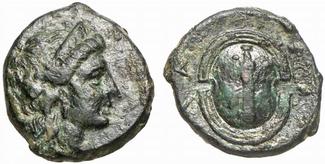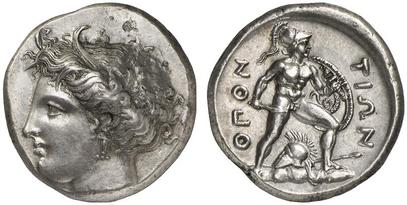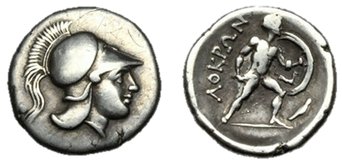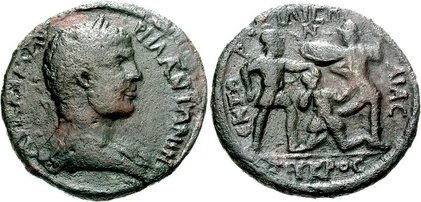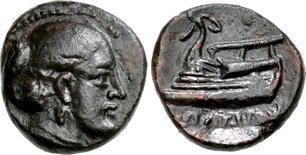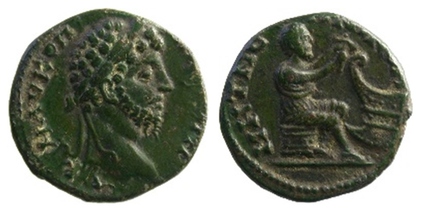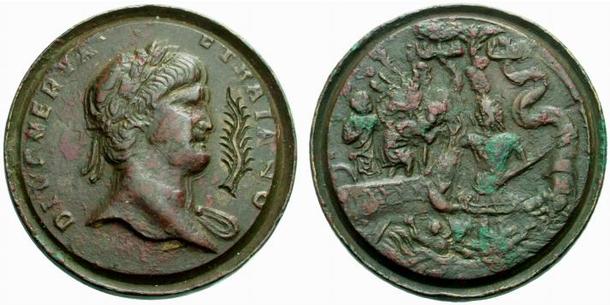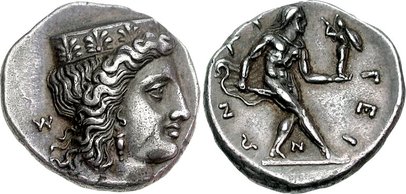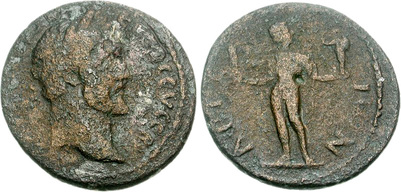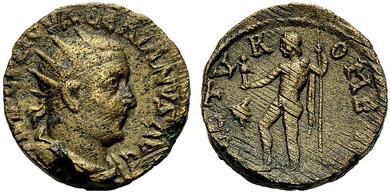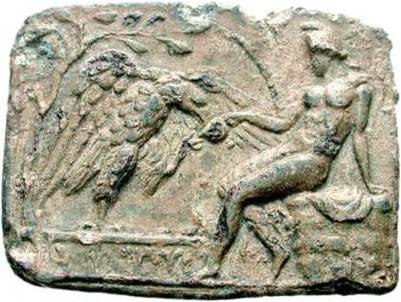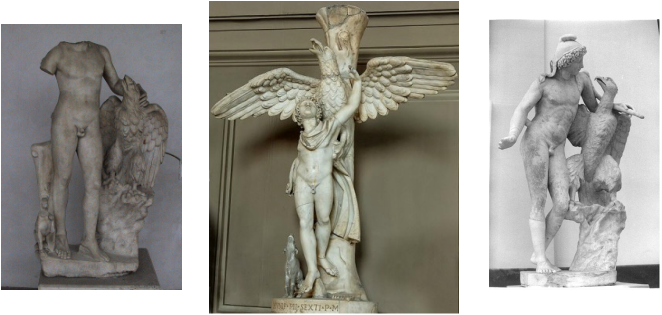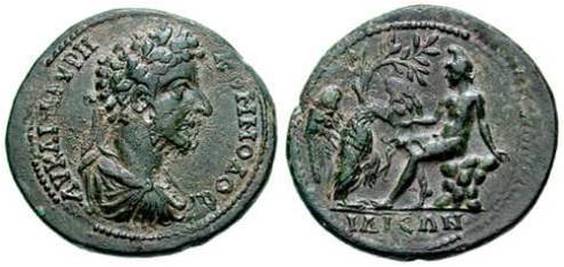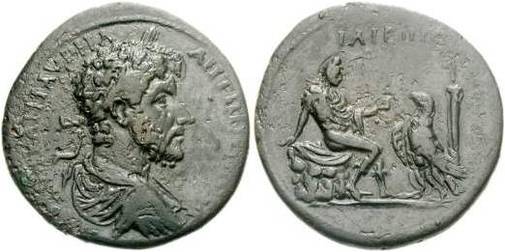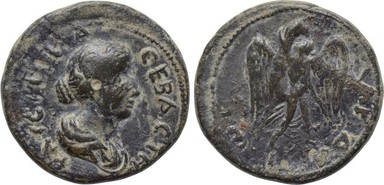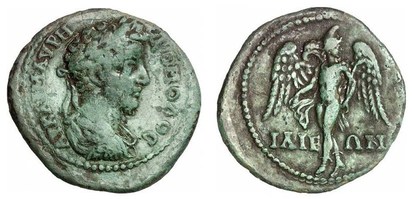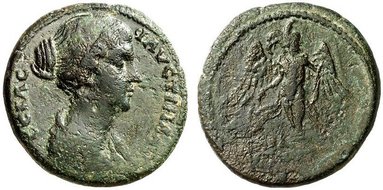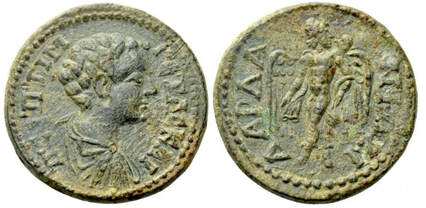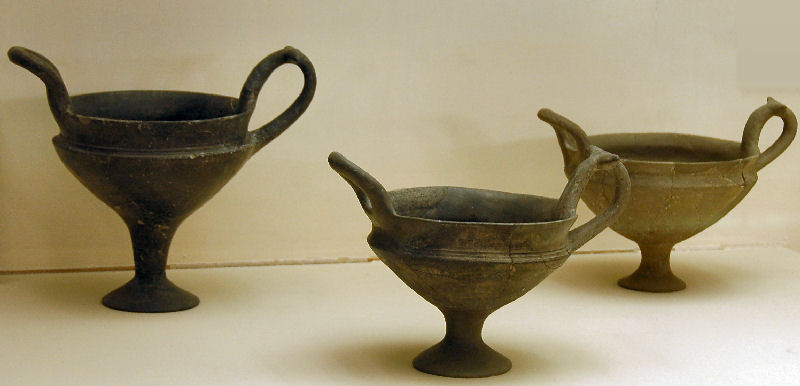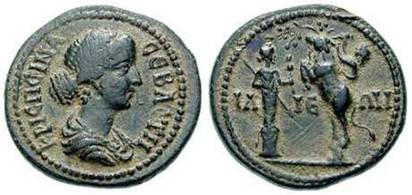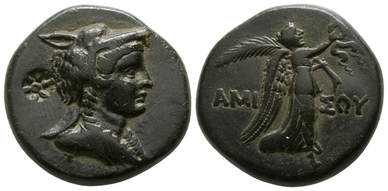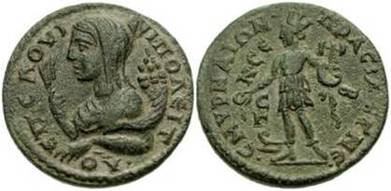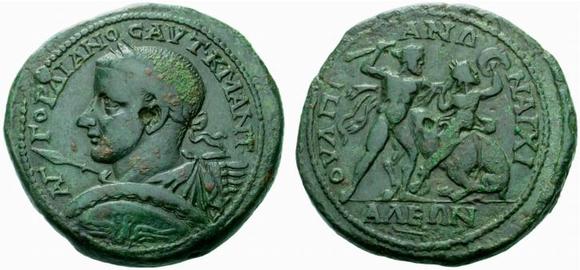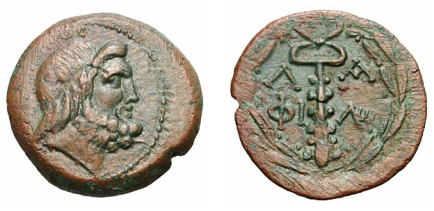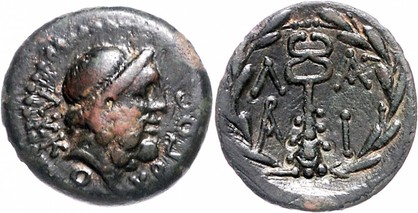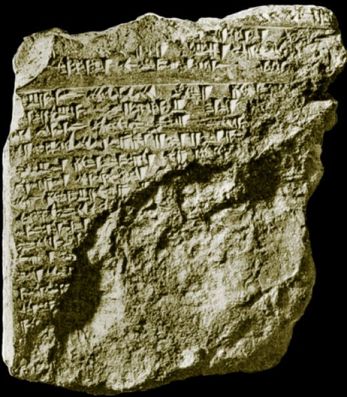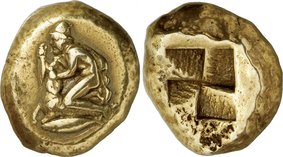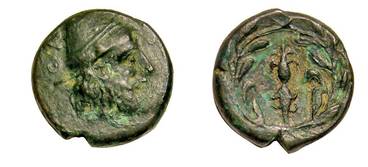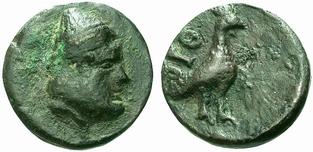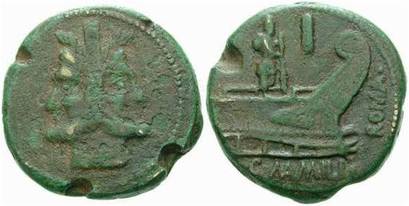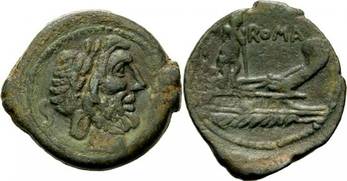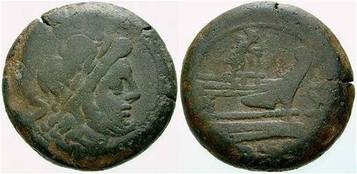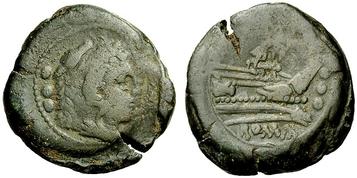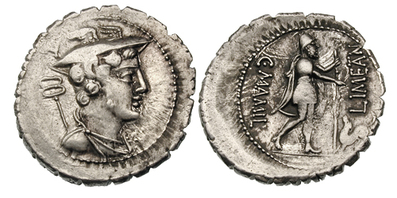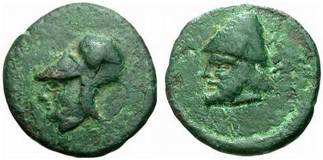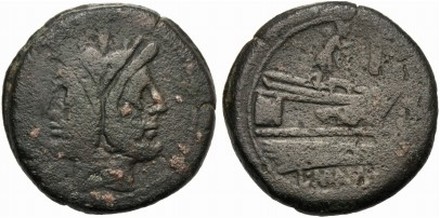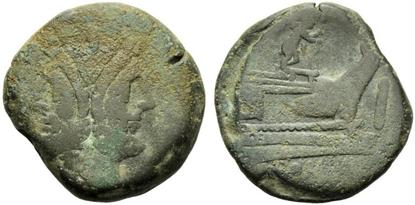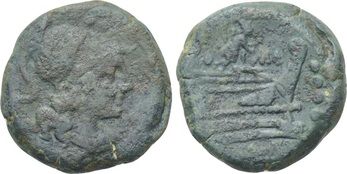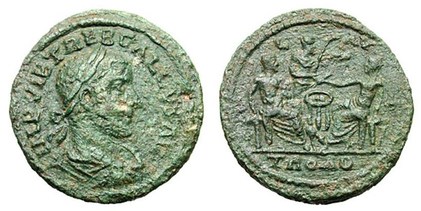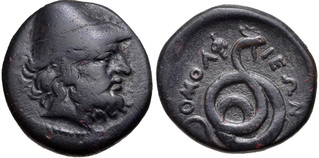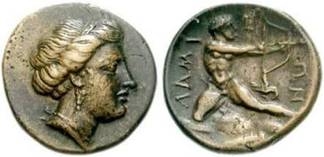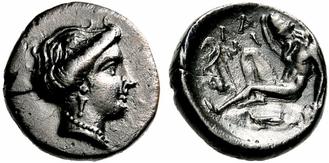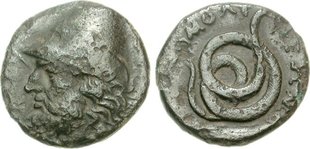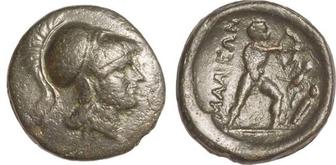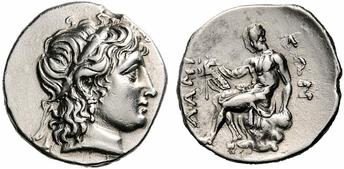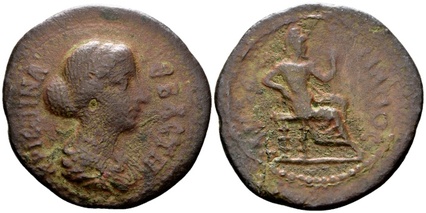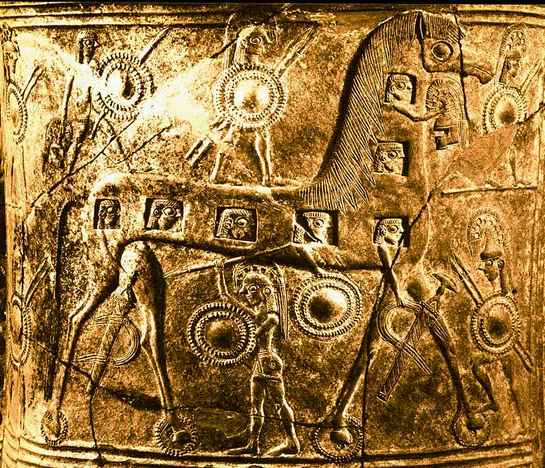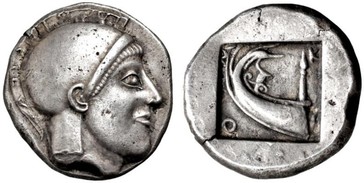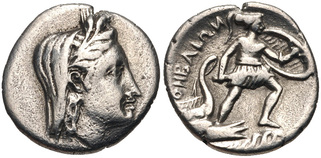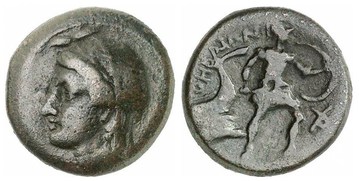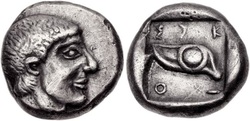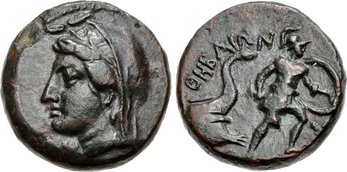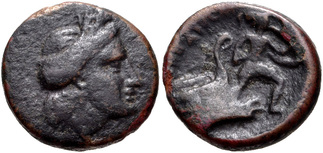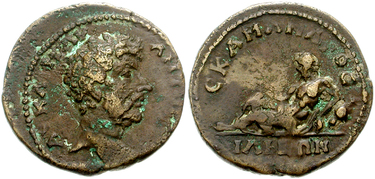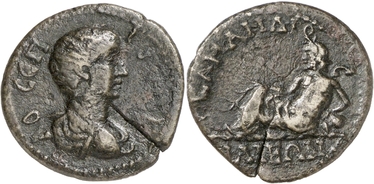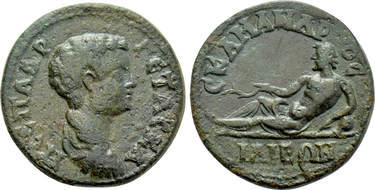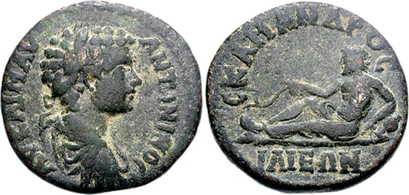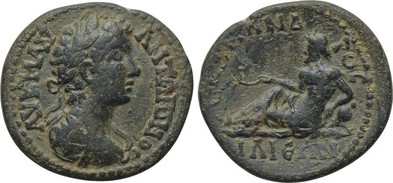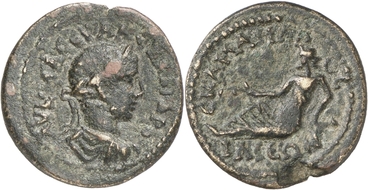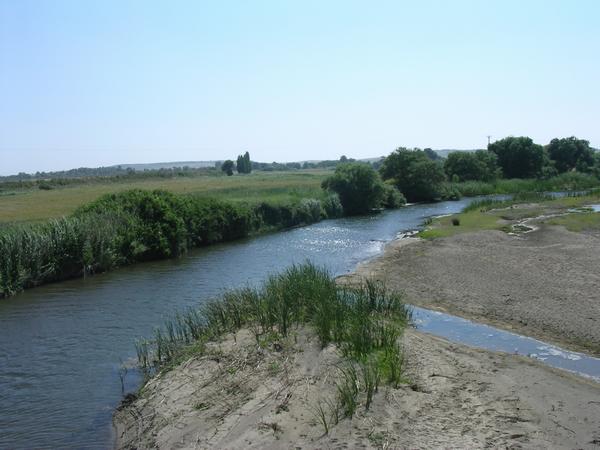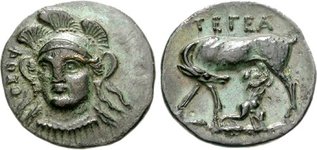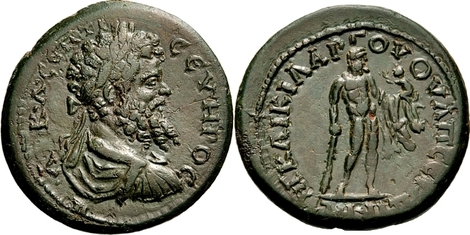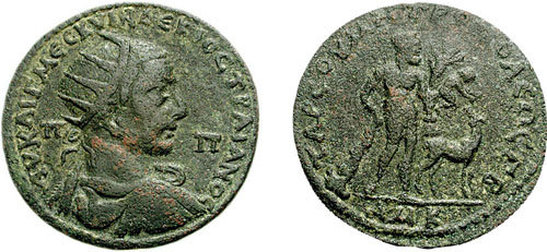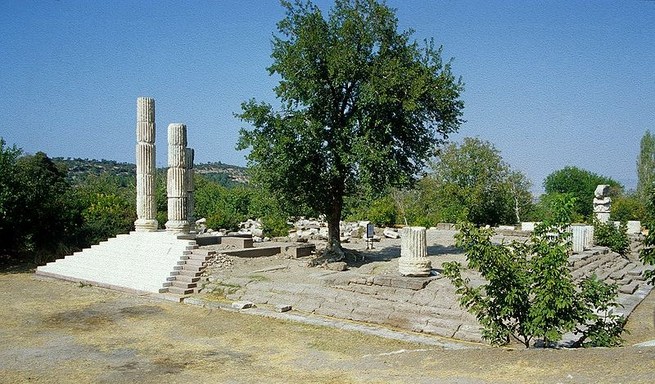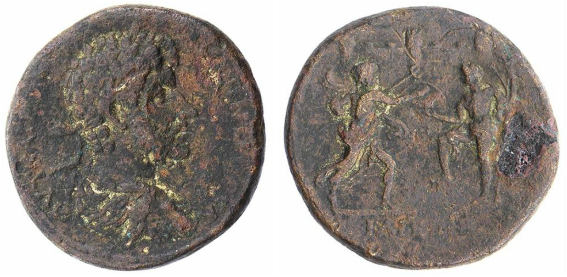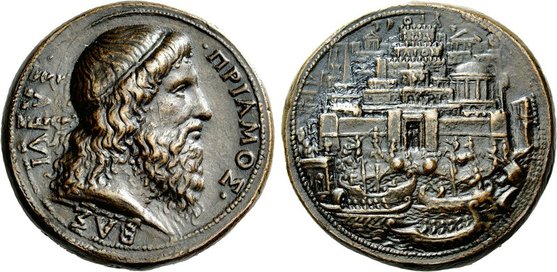The Trojan War
Trojan War mythology is rich and complex. The numismatic depictions of this mythology are equally compelling. The following section serves to highlight the major characters and events of this epic drama in ancient history.
The Trojan War has its roots in the marriage between Peleus and Thetis. Peleus and Thetis chose not to invite Eris (the goddess of discord) to the celebration of their union. As myth retells the tale, the outraged goddess stormed into the banquet and threw a golden apple onto the table. Looking to seed envy and strife, Eris proclaimed that the golden apple would belong to whomever was the fairest. Hera, Athena, and Aphrodite each reached for the apple. However, Zeus proclaimed that Paris (a prince of Troy and believed to be the most handsome man alive) would act as the judge. Hermes went to Paris and Paris agreed to act as the judge.
Hera promised him power, Athena promised him wealth, and Aphrodite promised the most beautiful woman in the world. Paris chose Aphrodite, and (at his request) she promised that Helen, the wife of Menelaus (King of Sparta), would be his wife. Accordingly, Paris set sail for Sparta in order to capture Helen.
While in Sparta, Paris was treated as a royal guest by Helen's husband, Menelaus. However, when Menelaus left Sparta to go to a funeral, Paris abducted Helen and returned to Troy. Once in his homeland the two were married. Outraged, Menelaus called upon Helen's previous suitors to help him get her back and defend his honor. Many of the suitors did not wish to go to war (e.g., Odysseus pretended to be insane). Achilles was also sought for the mission because Calchas (a seer) had prophesied that Troy would not be taken unless Achilles fought for the Greeks.
The Greek fleet came together under Agamemnon's leadership (brother to Menelaus). Agamemnon however, had previously offended Diana and as a result, the goddess calmed the seas so that the fleet could not take off. The seer Calchas proclaimed that Iphigenia, daughter of Agamemnon, must be sacrificed before the fleet would be able to set sail. This was done, and the Greek ships set off in search of Troy. Finding Troy proved difficult, however, and the Greek fleet at first landed in Mysia. According to Herodotus, the Greeks were under the impression that Helen had been taken by the Teuthranians (Teucrians), and though the Teuthranians denied such allegations, the Greeks laid siege to the city. The Greeks ultimately prevailed, but suffered heavy casualties at the hands of Telephus, king of the Teuthranians, and returned to
Greece.
Telephus, who was wounded by Achilles, traveled to Greece in the hope of curing his injury. Telephus had been told by an oracle that only the person who wounded him could cure him. Achilles assented and Telephus told the Greeks how to get to Troy. Once arriving in Troy, Odysseus and Menelaus were sent as ambassadors to Priam (Paris' father, king of Troy). They demanded Helen (as well as treasure that was taken by Paris). Priam refused and Odysseus and Menelaus returned to the Greek ships with the announcement that war was inevitable.
During the first nine years of the Trojan war, the Greeks fought against Troys neighbors and coalition forces. The Greeks realized that Troy was being supplied by its neighboring kingdoms, so portions of the Greek invasion were sent to defeat these regional supporters. As well as destroying the Trojan economy, these battles allowed the Greeks to gather a large amount of resources and other spoils of war. The Greeks won many important battles and the Trojan hero Hector fell, as did the Trojan ally Penthesilea (Queen of the Amazons). However, the Greeks could not break down the walls of Troy. During their siege, Patroclus (Achilles companion) was killed and eventually even Achilles himself was felled by Paris.
Helenus, son of King Priam was captured by Odysseus. A prophetess, Helenus told the Greeks that Troy would not fall unless the following events took place, 1) Pyrrhus, Achilles' son, must fight in the war, 2) the bow and arrows of Hercules must be used by the Greeks against the Trojans, 3) the remains of Pelops, the famous Eleian hero, must be brought to Troy, and 4) the Palladium, a golden statue of Athena, must be stolen from Troy. In response, Phoenix persuaded Pyrrhus to join the war. Philoctetes had the bow and arrows of Hercules, but had been left by the Greek fleet in Lemnos because he had been bitten by a snake and his wound had a horrendous smell. Bitter about being left on the island by his Greek counterparts, Philoctetes was finally persuaded to rejoin the Greeks and the remains of Pelops were brought to Troy. Odysseus infiltrated Trojan defenses and stole the Palladium.
Still seeking to gain entrance into Troy, Odysseus devised a plan (aided by Athena) and ordered a large wooden horse to be built. Its insides were hollow so that Greek soldiers could hide inside it. Once the statue had been built, several Greeks, led by Odysseus, climbed inside. The rest of the Greek fleet sailed away, so as to deceive the Trojans.
One man, Sinon, was left behind. When the Trojans came to marvel at the huge creation, Sinon pretended to be angry with the Greeks, stating that they had deserted him. He assured the Trojans that the wooden horse was safe and would bring luck to the Trojans. Only two people, Laocoon and Cassandra, spoke out against the horse, but they were ignored. The Trojans celebrated what they thought was their victory, and dragged the wooden horse into Troy. That night, while the Trojans slept, Sinon released the Greeks from the horse and they proceeded to sack the city and its people. Priam was killed as he huddled by Zeus' altar and Cassandra was pulled from the statue of Athena and raped.
After the war, Polyxena, daughter of Priam, was sacrificed at the tomb of Achilles. Astyanax, son of Hector, was also sacrificed. Aeneas, one of the last Trojan princes, managed to escape the destruction of Troy. Virgil's Aeneid tells of his flight from Troy. Many sources say that Aeneas was the only Trojan prince to survive, but this statement contradicts the common story that Andromache was married to Helenus, twin of Cassandra, after the war.
Menelaus, who had been determined to kill his wife (in revenge for her betrayal), was so taken by Helen's beauty that he allowed her to live. The surviving Trojan women were divided among the Greek men along with the other plunder and the Greeks then set sail for home.
The Trojan War has its roots in the marriage between Peleus and Thetis. Peleus and Thetis chose not to invite Eris (the goddess of discord) to the celebration of their union. As myth retells the tale, the outraged goddess stormed into the banquet and threw a golden apple onto the table. Looking to seed envy and strife, Eris proclaimed that the golden apple would belong to whomever was the fairest. Hera, Athena, and Aphrodite each reached for the apple. However, Zeus proclaimed that Paris (a prince of Troy and believed to be the most handsome man alive) would act as the judge. Hermes went to Paris and Paris agreed to act as the judge.
Hera promised him power, Athena promised him wealth, and Aphrodite promised the most beautiful woman in the world. Paris chose Aphrodite, and (at his request) she promised that Helen, the wife of Menelaus (King of Sparta), would be his wife. Accordingly, Paris set sail for Sparta in order to capture Helen.
While in Sparta, Paris was treated as a royal guest by Helen's husband, Menelaus. However, when Menelaus left Sparta to go to a funeral, Paris abducted Helen and returned to Troy. Once in his homeland the two were married. Outraged, Menelaus called upon Helen's previous suitors to help him get her back and defend his honor. Many of the suitors did not wish to go to war (e.g., Odysseus pretended to be insane). Achilles was also sought for the mission because Calchas (a seer) had prophesied that Troy would not be taken unless Achilles fought for the Greeks.
The Greek fleet came together under Agamemnon's leadership (brother to Menelaus). Agamemnon however, had previously offended Diana and as a result, the goddess calmed the seas so that the fleet could not take off. The seer Calchas proclaimed that Iphigenia, daughter of Agamemnon, must be sacrificed before the fleet would be able to set sail. This was done, and the Greek ships set off in search of Troy. Finding Troy proved difficult, however, and the Greek fleet at first landed in Mysia. According to Herodotus, the Greeks were under the impression that Helen had been taken by the Teuthranians (Teucrians), and though the Teuthranians denied such allegations, the Greeks laid siege to the city. The Greeks ultimately prevailed, but suffered heavy casualties at the hands of Telephus, king of the Teuthranians, and returned to
Greece.
Telephus, who was wounded by Achilles, traveled to Greece in the hope of curing his injury. Telephus had been told by an oracle that only the person who wounded him could cure him. Achilles assented and Telephus told the Greeks how to get to Troy. Once arriving in Troy, Odysseus and Menelaus were sent as ambassadors to Priam (Paris' father, king of Troy). They demanded Helen (as well as treasure that was taken by Paris). Priam refused and Odysseus and Menelaus returned to the Greek ships with the announcement that war was inevitable.
During the first nine years of the Trojan war, the Greeks fought against Troys neighbors and coalition forces. The Greeks realized that Troy was being supplied by its neighboring kingdoms, so portions of the Greek invasion were sent to defeat these regional supporters. As well as destroying the Trojan economy, these battles allowed the Greeks to gather a large amount of resources and other spoils of war. The Greeks won many important battles and the Trojan hero Hector fell, as did the Trojan ally Penthesilea (Queen of the Amazons). However, the Greeks could not break down the walls of Troy. During their siege, Patroclus (Achilles companion) was killed and eventually even Achilles himself was felled by Paris.
Helenus, son of King Priam was captured by Odysseus. A prophetess, Helenus told the Greeks that Troy would not fall unless the following events took place, 1) Pyrrhus, Achilles' son, must fight in the war, 2) the bow and arrows of Hercules must be used by the Greeks against the Trojans, 3) the remains of Pelops, the famous Eleian hero, must be brought to Troy, and 4) the Palladium, a golden statue of Athena, must be stolen from Troy. In response, Phoenix persuaded Pyrrhus to join the war. Philoctetes had the bow and arrows of Hercules, but had been left by the Greek fleet in Lemnos because he had been bitten by a snake and his wound had a horrendous smell. Bitter about being left on the island by his Greek counterparts, Philoctetes was finally persuaded to rejoin the Greeks and the remains of Pelops were brought to Troy. Odysseus infiltrated Trojan defenses and stole the Palladium.
Still seeking to gain entrance into Troy, Odysseus devised a plan (aided by Athena) and ordered a large wooden horse to be built. Its insides were hollow so that Greek soldiers could hide inside it. Once the statue had been built, several Greeks, led by Odysseus, climbed inside. The rest of the Greek fleet sailed away, so as to deceive the Trojans.
One man, Sinon, was left behind. When the Trojans came to marvel at the huge creation, Sinon pretended to be angry with the Greeks, stating that they had deserted him. He assured the Trojans that the wooden horse was safe and would bring luck to the Trojans. Only two people, Laocoon and Cassandra, spoke out against the horse, but they were ignored. The Trojans celebrated what they thought was their victory, and dragged the wooden horse into Troy. That night, while the Trojans slept, Sinon released the Greeks from the horse and they proceeded to sack the city and its people. Priam was killed as he huddled by Zeus' altar and Cassandra was pulled from the statue of Athena and raped.
After the war, Polyxena, daughter of Priam, was sacrificed at the tomb of Achilles. Astyanax, son of Hector, was also sacrificed. Aeneas, one of the last Trojan princes, managed to escape the destruction of Troy. Virgil's Aeneid tells of his flight from Troy. Many sources say that Aeneas was the only Trojan prince to survive, but this statement contradicts the common story that Andromache was married to Helenus, twin of Cassandra, after the war.
Menelaus, who had been determined to kill his wife (in revenge for her betrayal), was so taken by Helen's beauty that he allowed her to live. The surviving Trojan women were divided among the Greek men along with the other plunder and the Greeks then set sail for home.
Coinage Depicting elements from Trojan War Mythology
Homer
As author and poet, Homer was believed to have been from Ionia. As such, he has been a prominent figure on the coinage of Smyrna as well as Kolophon. Strabo mentions specifically the issue of bronze coinage from Smyrna when, discussing the city, he says there is also a library, and the Homereum, a quadrangular portico containing a shrine and wooden statue of Homer. The Smyrnaeans laid special claim to the poet and indeed a bronze coin of theirs is called a Homereum (Strabo, Geographica XIV, I.37, transl. by H.C. Jones, The Geography of Strabo, VI (Loeb, 1960), pp. 245-247).
|
|
|
Coins of the Judgment of Paris
Before the birth of her second son, Hecuba, wife of King Priam of Troy, dreamed that her child would destroy the city, and therefore, the new born child was left to die of exposure on Mount Ida. Brought up by a shepherd, he was named Paris, and later, by his courage, earned the name Alexander or defender of men. He was beloved by the nymph Oenone, but he deserted her (when asked to judge the divine beauty of Hera, Athena, and Aphrodite). When Hermes came to Mount Ida with the three goddesses he called Paris and said to him, "Come here and decide which is the more excellent beauty of face, and to the fairer give this apple's lovely fruit." (Colluthus, The Rape of Helen 130).
While Paris reflected, the goddesses, who for the occasion had bathed their immortal bodies, offered him bribes in order to win the apple. Athena offered him the command of Phrygia and the destruction of Hellas, or as some say, that he would be bravest of mortals and skilled in every craft. Likewise Hera offered him dominion over Asia and Europe. But Aphrodite offered him the hand of Helen, whose beauty was famous worldwide, and this bribe won her the apple.
While Paris reflected, the goddesses, who for the occasion had bathed their immortal bodies, offered him bribes in order to win the apple. Athena offered him the command of Phrygia and the destruction of Hellas, or as some say, that he would be bravest of mortals and skilled in every craft. Likewise Hera offered him dominion over Asia and Europe. But Aphrodite offered him the hand of Helen, whose beauty was famous worldwide, and this bribe won her the apple.
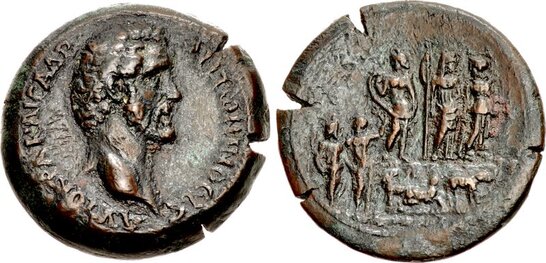
EGYPT, Alexandria
Antoninus Pius
141 - 142 A.D. Æ Drachm 35mm, 26.34 g, 12h
Obv.: Laur. bust r. of emperor
ΑΥΤ Κ Τ ΑΙΛ ΑΔΡ
ΑΝΤΩΝΙΝΟΣ ΕΥΣΕΒ
Rev.: Judgment of Paris;
Aphrodite, Hera, and Athena
on rocks, Paris and Hermes
stand, judging their beauty; L Ε
Ref: RPC collection # 15609
(image courtesy of Triton XXI)
Coins of Achilles
Achilles was the son of Peleus and the Nereid Thetis. Thetis attempted to make her son immortal by dipping him into the river Styx. To do so, she held him by his heel. Everything the sacred waters touched became invulnerable, but the heel remained dry and therefore unprotected (a foreboding vulnerability that would fall prey to Paris' arrow during the war).
When Achilles was a boy, the seer Calchas prophesied that the city of Troy would not be taken without his help. Thetis knew that, if her son went to Troy, he would die, so she sent him to the court of Lycomedes, where he was hidden and disguised as a young girl. During his stay he had an affair with Lycomedes' daughter, Deidameia, and she bore him a son, Pyrrhus.
Achilles' disguise was discovered by Odysseus who convinced him to join the Greeks as they headed off to Troy. Achilles led his father's Myrmidons and was accompanied by his tutor Phoenix and his close companion, Patroclus. At Troy, Achilles distinguished himself as the consummate warrior. Following the death of Patroclus (at the hand of the Trojan hero Hector), Achilles was enraged. He took the armor his mother had received from Hephaestus and killed Hector. He desecrated the body, dragging it behind his chariot before the walls of Troy, and refused to allow him funeral rites. When Priam, the king of Troy and Hector's father, came secretly into the Greek camp to plead for the body, Achilles relented.
Achilles continued fighting heroically, killing many of the Trojans and their allies, including Memnon and the Amazon warrior queen Penthesilia. Finally Priam's son Paris, aided by Apollo, wounded Achilles in the heel with an arrow; Achilles died of the wound. After his death, it was decided to award Achilles' divinely-wrought armor to the bravest of the Greeks. Odysseus and Ajax competed for the prize, with each man making a speech explaining why he deserved the honor; Odysseus won, and Ajax then went mad and committed suicide (see coinage of Ajax falling on his dagger next to a pile of Achilles' armor).
When Achilles was a boy, the seer Calchas prophesied that the city of Troy would not be taken without his help. Thetis knew that, if her son went to Troy, he would die, so she sent him to the court of Lycomedes, where he was hidden and disguised as a young girl. During his stay he had an affair with Lycomedes' daughter, Deidameia, and she bore him a son, Pyrrhus.
Achilles' disguise was discovered by Odysseus who convinced him to join the Greeks as they headed off to Troy. Achilles led his father's Myrmidons and was accompanied by his tutor Phoenix and his close companion, Patroclus. At Troy, Achilles distinguished himself as the consummate warrior. Following the death of Patroclus (at the hand of the Trojan hero Hector), Achilles was enraged. He took the armor his mother had received from Hephaestus and killed Hector. He desecrated the body, dragging it behind his chariot before the walls of Troy, and refused to allow him funeral rites. When Priam, the king of Troy and Hector's father, came secretly into the Greek camp to plead for the body, Achilles relented.
Achilles continued fighting heroically, killing many of the Trojans and their allies, including Memnon and the Amazon warrior queen Penthesilia. Finally Priam's son Paris, aided by Apollo, wounded Achilles in the heel with an arrow; Achilles died of the wound. After his death, it was decided to award Achilles' divinely-wrought armor to the bravest of the Greeks. Odysseus and Ajax competed for the prize, with each man making a speech explaining why he deserved the honor; Odysseus won, and Ajax then went mad and committed suicide (see coinage of Ajax falling on his dagger next to a pile of Achilles' armor).
|
|
|

ISLANDS OFF IONIA, Samos. Gallienus, 253-268. Tetrassarion (29 mm, 12.90 g, 6 h). AYT ΠO ΛIK ΓAΛΛIHNOΣ AYΓΟ Radiate and draped bust to left, holding spear and shield. Rev. CAMIΩN Achilles, helmeted and naked, standing facing, head left, holding round shield in left hand; below shield and behind the legs, uncertain long object (vine trunk?). BMC -. BMFA -. Lindgren I+III -. Imhoof-Blumer KM -. SNG Copenhagen -. SNG Glasgow -. SNG Leypold -. SNG Righetti -. SNG von Aulock -. Apparently unpublished and unique. ex. Leu web 1, lot #749 (June 2017)
The figure on the reverse is clearly different from the usual warrior in chiton advancing right on prow and gesturing troops to follow (BMC 348 and 384): not only is the hero resting, but he is also naked, with the exception of wearing a helmet. The latter is clearly reminiscent of the Samos issue with Achilles stabbing Penhesilea, the queen of the Amazons, in battle during the siege of Troy (BMFA 1984.257 and Auctiones GmbH 18, 2013, 51). Another similarity lies in the uncertain object behind the legs, which also appears on the Boston and Auctiones examples: it might be part of a long clamys, although its supporting position points towards a more static object, possibly a vine trunk. While this identification remains uncertain for the time being, there can be little doubt that the hero is, in fact, Achilles the Thessalian, the strongest warrior of the Greeks. (Author's collection)
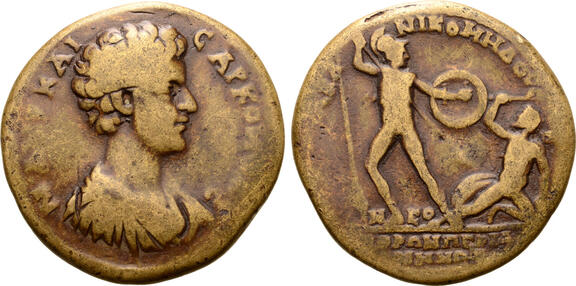
MYSIA, Pergamum. Commodus, as Caesar AD 175-176. Æ 34mm 20.07g, 12h. Kl. Nikomedes, strategos. M ΑVΡ ΚΑΙϹΑΡ ΚΟΜΟΔΟϹ, bare-headed and cuirassed bust right, wearing paludamentum / [ΕΠΙ ϹΤΡΑ ΚΛ] ΝΙΚΟΜΗΔΟVϹ Β ΝΕΟΚΟΡΩΝ ΠΕΡΓΑΜΗΝΩΝ, Achilles standing to right, holding shield and aiming spear at Telephus, fallen on knees below, who holds sword and raising right hand, shield below; upright spear to left. RPC IV.2 Online 3245 (temporary); Weisser 1060; SNG BnF 2149. (Bill Hearn collection)
Telephus, the son of Hercules and Aug, was king of Mysia and founded Pergamum. He was wounded by Achilles when the Achaeans came to his kingdom mistaking it for Troy on their journey to bring Helen back to Sparta. Despite defeating the Greeks, the wound which Achilles had inflicted upon Telephus would not heal. Telephus sought the advice of the oracle of Apollo which gave him the reply "your assailant will heal you". He was later healed by Achilles after travelling to Argos and in return guided the Greeks to Troy.
Pergamus (grandson of Achilles)

MYSIA, Pergamum. Gallienus. AD 253-268. Æ (36mm, 18.77 g, 6h). Sextus Claudius Silianus, Asiarch. Laureate, draped, and cuirassed bust right, seen from behind / Pergamus standing facing, head right, receiving ram's head from Hermes(?); open capsa (scroll case) on ground between. Weisser, Pergamon 2530; RPC X Online 62138 (this coin cited); SNG BN 2294 var. (magistrate); BMC Mysia 347. Ex Classical Numismatic Group Electronic Auction 277 (11 April 2012), lot 117.
As both male figures on this coin are nude, one may conclude that they are heroes. The individual on the left, who receives the ram's head, must be Pergamus, the grandson of Achilles and the eponymous re-founder of Pergamum. The figure on the right is less certain, since he lacks any specific attributes. Wroth and Levante have suggested Hermes. The object on the ground between the two figures has been described, on the basis of imperfectly preserved specimens, as an altar. Better preserved examples clearly show it to be an open capsa, or scroll case. Pergamum was the inventor and chief supplier for parchment, a writing material made of sheep's skin, and much of the city's revenue came from the sale of this material. The presentation of the source of this wealth (the ram's head) by the god of business (Hermes) to the eponymous founder of the city (Pergamus) over the capsa, makes a noteworthy allusion to the city’s good fortune. (Author's collection)
Achilleion
History seems to suggest that this "place of Achilles" in Troad is where Achilles was laid to rest following the Trojan War. According to Cicero, Alexander the Great, during his 4th century B.C. expansion of Greek territory, paid homage at Achilles' tomb located here. Caracalla followed suit during his 3rd century war against the Parthians.
Achilles killing the Amazon Queen Penthesilea
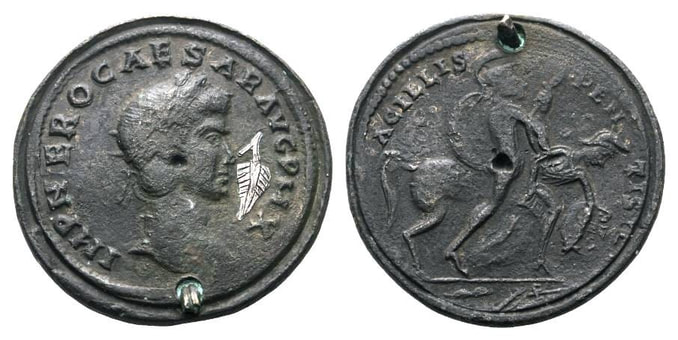
Roman Æ Contorniate, late 4th century A.D. Obverse: IMP NERO CAESAR AVG P M X (sic), Laureate head of Nero right, silver inlay pal-branch in right field. Reverse: ACILLIS PENTISILEA, Achilles, with sword and shield, advancing right in the act of knocking the Amazon queen Penthesilea to the ground in order to kill her, horse to right behind and fallen arms in exergue. Unpublished in the standard references, for general type cf. A. Alföldi, Die Kontorniat-Medaiions, p.61, 196, pl. 73, 12 (unique). 39.03g, 42mm, 6h. pierced with part of suspension loop still in hole. (formerly Author's collection)
Penthesilea was an Amazonian queen in Greek mythology, the daughter of Ares and Otrera and the sister of Hippolyta, Antiope and Melanippe. While hunting deer, Penthesilea accidentally killed her sister Hippolyta with a spear; this accident caused Penthesilea so much grief that she wished only to die, but, as a warrior and an Amazon, she had to do so with honor (and in battle). She therefore was easily convinced to join in the Trojan War, fighting on the side of Troy's defenders. Penthesilea arrived in Troy with twelve companions and promised the Trojans that she would kill Achilles. On her first and only day of fighting, Penthesilea killed many men and tried to fight Telamonian Ajax, but he had merely laughed off her attempts, thinking her an unfit opponent. Ajax summoned Achilles, who with only one blow to her breastplate, knocked her to the ground. Penthesilea begged for her life, but an unmoved Achilles killed her and mocked her corpse; upon removing her helmet; however, he was struck by her beauty felt a great remorse, whereupon he cradled her body and lamented her death (the scene captured on the coin above). The Greek Thersites made fun of Achilles's kindness shown to Penthesilea's body, whereupon Achilles killed him. However, Thersites' cousin Diomedes, became enraged at Achilles' action and he harnessed Penthesilea's corpse behind his chariot, dragged it and cast it into the Scamander river. Achilles retrieved the body and gave it a decent burial.
Alexander As Achilles
Where ever Alexander traveled he was known to have carried with him one of his most precious possessions - Aristotle's personal copy of the Iliad which the famous philosopher had given him. When Alexander led his Macedonian army to the Hellespont, he desired two things, to be the new Achilles sailing once again for Troy, and to be the captain general of the Hellenes exacting vengeance for the invasion of Greece by the Persian king Xerxes in 480 BC.
Where ever Alexander traveled he was known to have carried with him one of his most precious possessions - Aristotle's personal copy of the Iliad which the famous philosopher had given him. When Alexander led his Macedonian army to the Hellespont, he desired two things, to be the new Achilles sailing once again for Troy, and to be the captain general of the Hellenes exacting vengeance for the invasion of Greece by the Persian king Xerxes in 480 BC.
Coins of Hephaestus and the Armor of Achilles
An episode in the Illiad recounts that the Achilles' mother, Thetis, approached Hephaestus and asked him to make new armor for her son, who was grieving over the death of Patroclus. Achilles was without armor because Patroclus had worn it into battle while leading the Myrmidions against the Trojans. Hector slew Patroclus and took the armor as spoils of war. Hephaestus, who favored the Greek cause, made new armor for Achilles, including a helmet, breastplate, and an ornate shield that Homer describes in great detail. Thetis and Athena delivered the new armor to Achilles, who wore it into battle against Hector, who confronted him wearing Achilles's old armor. As both sets of divine armor could not be pierced by mortal weapons, the battle raged for some time before, with Athena's help, Achilles thrust his spear through a gap in Hector's breastplate.
The coin below depicts Athena (as goddess of battle strategy and wisdom) with Hephaestos as he shapes Achilles' armor.
The coin below depicts Athena (as goddess of battle strategy and wisdom) with Hephaestos as he shapes Achilles' armor.
Chiron the Centaur (Achilles' Athletic Trainer)
Chiron the Centaur was highly respected in antiquity as an oracle, an astrologer, and a teacher of a number of Greek heroes; most notably, he was the athletic instructor of the hero Achilles.
Coins Depicting Hector, Hero and Prince of Troy
In Homer's Iliad, warriors are portrayed as riding to battle in chariots driven by other soldiers or by specialist drivers. These warriors then dismounted and fought on foot while their chariots were held nearby (ready for retreat if necessary). There was little in the way of formal tactics for fighting from chariots. Their main purpose was to deliver a warrior swiftly to a desired location on the field of battle. They were also used to charge or break enemy formations.
Hector, (meaning holder or resister), was the son of the Trojan king Priam and Hecuba (Hekabe). He was husband to Andromache and the father of Astyanax. History tells us he was the bravest of the Trojan heroes and a favorite of Apollo. Hector is typically depicted charging in his chariot. During the Trojan War, Hector (with Apollo's help) killed Patrocles and so obliged Achilles to join the other Greeks in fighting the Trojans.
Hector, (meaning holder or resister), was the son of the Trojan king Priam and Hecuba (Hekabe). He was husband to Andromache and the father of Astyanax. History tells us he was the bravest of the Trojan heroes and a favorite of Apollo. Hector is typically depicted charging in his chariot. During the Trojan War, Hector (with Apollo's help) killed Patrocles and so obliged Achilles to join the other Greeks in fighting the Trojans.
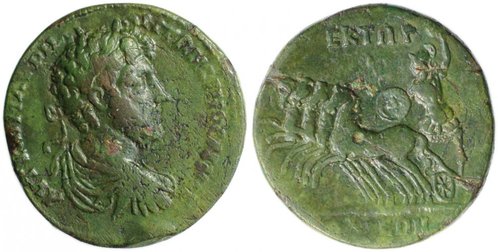
TROAS, Ilion (Troy)
Marcus Aurelius 161-180 A.D.
Æ 35mm 26.36g
Obv: Laur. bust of emperor r.
AVT KAI MA AVPHL
ANTΩNEINOC
Rev: Hektor driving quadriga
w/ shield and spear
EKTΩP IΛIEΩN
Ref: Bellinger T147
(image courtesy of Monoco auctions, Editions V. Gadoury (Jan 2012), lot 257; Author's collection)
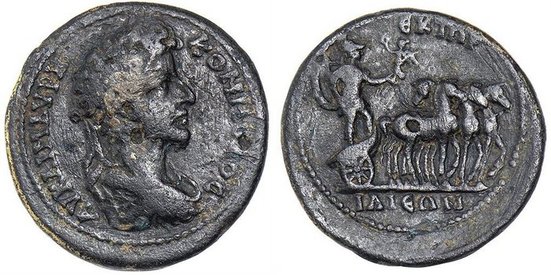
TROAS, Ilion (Troy)
Commodus 177-180 A.D.
(36mm, 21.67g)
Obv: Laur. bust of emperor r.
AVKΛIMAYPH KOMMOΔOC
Rev: Hektor standing r., shield
strapped to back, holding spear,
Nike who crowns him with wreath,
in triumphal quadriga right
EKTΩP / IΛIEΩN
Ref: Bellinger T185; ex. Herbert F. Johnson Museum of Art, Cornell University, 1994), p. 21, 102 (this coin); ex. Cornelius Vermeulen collection (Stacks 2010 #265); ex. Simpson collection (Triton V 2002 #1720)
(Author's collection)
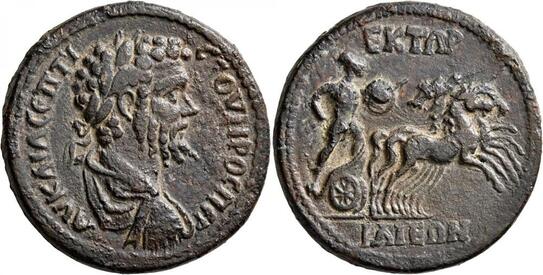
TROAS. Ilium. Septimius Severus, 193-211. Medallion (35 mm, 31.64 g, 1 h). AY K AIΛ CЄΠTI CЄOYHPOC ΠЄP Laureate, draped and cuirassed bust of Septimius Severus to right, seen from behind. Rev. EKTΩP / IΛIEΩN Hektor, holding spear in his right hand and shield in his left, driving fast quadriga to right. Bellinger -, cf. T184 (for Commodus) and pl. 10, T216 (same obverse die, but Hektor with shield on his back and holding Nike in his hand, driving slow quadriga to right). BMC -. SNG Copenhagen -. SNG München -. SNG Leypold -. SNG von Aulock -. Apparently unpublished - heavily cleaned and lightly tooled. ex. Savoca 20 (Jan 2018), lot 257; ex. Leu 4, lot 432 (May 2019) (Author's collection)
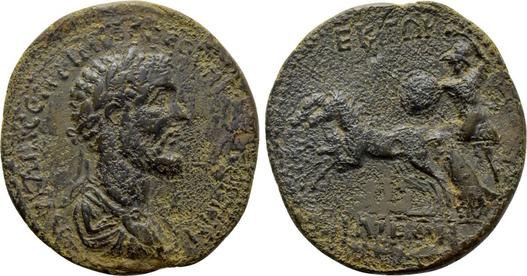
TROAS. Ilium. Septimius Severus (193-211 AD). Ae Sestertius 38mm 21.14g Obv: AY KAI Λ CЄΠTIMIOC CЄOYHPOC ΠЄPTIN. Laureate, draped and cuirassed bust right. Rev: EKTΩP / IΛIEΩN. Hector, raising arm and holding spear and shield, in a chariot galloping right. Bellinger T215 (formerly Author's collection)
Coins of Aeneas and Anchises
According to Vergil, Aeneas, the son of the goddess Venus and the Trojan Anchises, fled with some remnants of the inhabitants of Troy as it fell to the Greeks, taking with him his son, Ascanius, his elderly father, Anchises, and the Palladium. The Trojans eventually made their way west to resettle in Italy. There they intermarried with the local inhabitants and founded the town of Lavinium, and thereby became the nucleus of the future Roman people. One of the descendants of Aeneas’ son Ascanius (known now as Iulus) was Rhea Silvia. As legend tells it, she was impregnated by the god Mars and gave birth to the twins, Romulus and Remus. They were left to die of exposure by their great-uncle, Amulius, however, the twins were suckled by a she-wolf and kept alive. Romulus later founded the city of Rome, and consequently the image of the she-wolf and the twins became the symbol of that city. The mythological depictions on this coin reinforce the importance of Ilium, not only as the seedbed of the future Roman people, but also as the mother city of the future caput mundi. Aeneas, a Trojan prince, managed to escape the destruction of Troy, and Virgil's Aeneid tells of his flight from Troy.
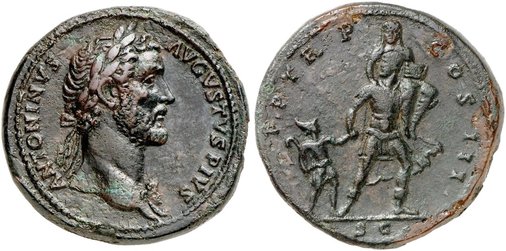
Antoninus Pius. AD 138-161 (140-144 AD) Æ Sestertius 26.52g. Prince Aeneas carrying Anchises and holding Ascanius by the hand as they flee from Troy. Banti 309 (this coin illustrated); BMC 1264; Cohen 655; RIC 615/627 (Author's collection) - impeccable provenance: ex. Kunst und Münzen AG XXIX, Lugano 1993, no. 384; ex. Henry Platthall Collection, Part I, Glendining Auction, London, November 16, 1950, No. 1458; ex. collection Vierordt, auction Jacques Schulman 139, Amsterdam 1923, no. 1479 and auctioneer 43, Vienna 1913, no. 943 and ex. ex. Jacob Hirsch auction 11, Munich 1904, no. 916. - formerly
author's collection
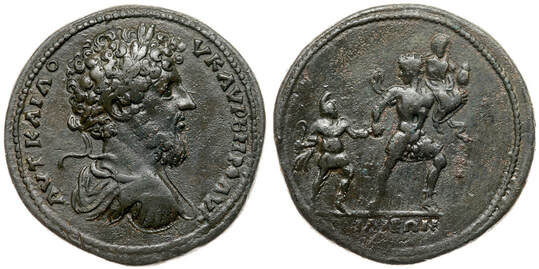
TROAS, Ilium
Lucius Verus 161-169 AD
Æ 36 mm (27.31 g)
Obv: AVT KAI ΛO-VK AVP BHPO AVΓ,
laureate, draped and cuirassed bust of
Lucius Verus right
Rev: IΛIEΩN, Aeneas advancing right,
head left, leading Ascanius by the hand
and carrying Anchises on his shoulder
Ref: Bellinger T154; RPC IV.2 Online
91.3 (this coin); Extremely Rare - only 3
Specimens noted in RPC, Finest example
ex Ed Waddell; ex Gorny 76 (22 April
1996), #318; ex NY Sale 55 #319
Finest known example (Author's collection)
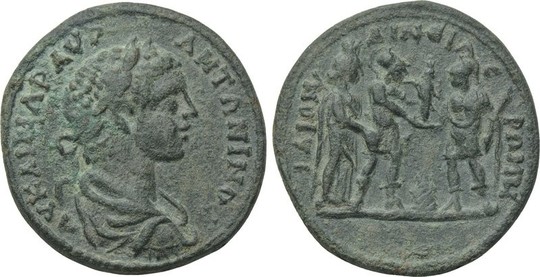
TROAS, Ilium. Elagabalus (218-222 AD). Æ Medallion 39mm 28.86g.
Obv: AY KAI MAP AYP ANTΩNINOC.
Laureate, draped and cuirassed bust right.
Rev: IΛΙΩΝ ΑΙΝΕΙΑC PΩΜΗ.
Tyche and Aeneas standing right, presenting statue of Athena Ilias to Roma, standing left; altar between them. Ref: RPC VI, 3938 (only example); SNG v. Aulock -; BMC -; Isegrim -; SNG France -; SNG Cop. -; Bellinger -. ex. Pecunem 24, Nov. 2014, 296 (Author's collection)
The sow and pigs refer back to a foundation myth of Rome, celebrating its 900th anniversary during the reign of Antoninus Pius. According to Vergil, The Trojan exile Aeneas sailed up the Tiber until he came upon a white sow nursing thirty piglets, and was to found a settlement on the site of this good omen, the town of Lanuvium, the precursor to Rome.
|
|
Coinage of Ajax (the Greater)
Ajax led the warriors of Salamis to Troy, and was regarded as the second greatest Greek warrior, after Achilles. When he failed to win Achilles' armor after the latter's tragic death, Ajax went mad and, after creating turmoil amidst the Greek ranks, finally committed suicide by falling on his sword.

BITHYNIA, Prusa ad Olympos. Macrinus 217 - 218 AD 24mm 7.76g Obv: ΜΑΚΡΕΙΝΟϹ ΑΥΓΟΥϹΤΟϹ; laureate head of Macrinus, right Rev: ΠΡΟΥϹΑΕΩΝ; Ajax falling upon his sword, left; to left, rocks; below, shield. Ref: RPC V.2, — (unassigned; ID 27419); only example. ex. Solidus Premium 18, 15 July 2017, lot 169 (Author's collection)
|
|
Coins of Ajax (the Lesser - son of Oileus)
The son of the Greek king Telamon of Salamis and his Trojan wife Hesione, Teucer was the half brother of the Greek hero Ajax the Greater, as well as the nephew of King Priam of Troy and cousin of Hector. Siding with the Greeks and hiding behind the giant shield of his half brother, Teucer used his skills as an archer to defend the Greeks against the Trojans. Enraged by Teucer's success during one of these fights, Hector picked up a huge rock and flung it at Teucer, injuring him so badly that he was forced to withdraw for some time while he recuperated from the concussion.
The Argo of the Argonauts
Jason and his band of heroes (many of whom would later fight in the Trojan War), travel in "the Argo" named after it's builder, Argus. Known as the Argonauts, these heroes traveled to Colchis in search of the Golden Fleece.
Scylla Attacking the Fleeing Trojans
Odysseus and his men experience many trials and tribulations on their way home following the Trojan War. One of those tales involve the famed sea monster, Scylla. After navigating his way past the deadly Sirens, Odysseus and his crew sail on to Scylla. As they approach Scylla's cave, they are set upon by the six-headed sea monster, each head consuming one of his men. Despite the losses, Odysseus and his remaining crewmates sail on.

CILICIA, Tarsus
Gordian III 238-244 A.D.
Æ 37mm 26.85g, 8h
Obv.: Radiate bust of emperor, facing right, ΑΥΤ Κ ΑΝΤ ΓΟΡΔΙΑΝΟϹ ϹΕΒ, Π Π
Rev.: Scylla, with two fish-tail and four dog-foreparts, facing, head left, raising right arm, holding rudder, ΤΑΡϹΟΥ ΜΗΤΡΟΠΟΛΕωϹ, Α Μ Κ Γ Β
Ref: SNG Levante 1125; RPC VII.2, 3100; Roma Numismatics 23, lot 325 (Jan 2016) (Author's collection)

CILICIA, Tarsus
Pupienus, 238 AD
Æ Hexassarion
Orichalcum, 35 mm, 20.80 g, 7 h
Obv: AYT KAIC M K Λ ΠΟYΠIHNON
CЄB / Π - Π. Radiate, draped and
cuirassed bust of Pupienus to right, seen
from behind.
Rev: TAPCOY MHTPOΠOΛЄΩC
A M / K Γ / Β Skylla facing, raising
her right hand holding rudder in her left;
her lower body is two dolphin tails and
four foreparts of dogs
Ref: Naumann 32 (2015), 347 var.
SNG Paris 1633 var.
(formerly Author's collection)
Coins of Diomedes
Diomedes, the heroic king of Argos, was one of the famous Achaeans who fought at Troy. He and the Greater Ajax were considered their second best warriors, after Achilles. In the Iliad, he is portrayed as a brilliant and courageous fighter, whose zeal in pitched battle led to the wounding of the goddess Aphrodite (Il. 5.330, 351). With the help of Odysseus, Diomedes stole the Palladion from its sanctuary in the Trojan citadel, thereby fulfilling the prophecy that by doing so would effect the downfall of Troy (Apollodoros, Epitome 5. 10, Konon, Diegesis 34).
The Palladium was a xoanon, or ancient wooden effigy, of Pallas Athena that had purportedly fallen from heaven. According to Apollodoros, it was fashioned by Athena and named in memory of Pallas, the daughter of Triton, who was accidentally killed while sporting with the goddess. It remained on Olympos until it was cast out of heaven into the countryside around Troy. It was discovered there by Ilos, who enshrined it in his newly founded city of Ilion (Troy), where it remained until the Trojan War.
Following its theft, many legends arose regarding the whereabouts of the Palladium. It was reputed to have remained in the possession of either Diomedes or Odysseus. The Athenians claimed that it was kept in the Erechtheion on the Acropolis and was ritually cleaned in an annual ceremony called the Plyntereia (the Clothes Washing Ceremony). The Roman poet Virgil asserted that the figurine had not been stolen at all, but had been saved by the Trojan hero Aeneas during Troy’s fall, and brought to Italy, where centuries later it was installed in the Temple of Vesta on the Roman Forum. In early Christian times, Clement of Alexandria claimed to have personally seen it and described it as, a shapeless, dark piece of wood.
The Palladium was a xoanon, or ancient wooden effigy, of Pallas Athena that had purportedly fallen from heaven. According to Apollodoros, it was fashioned by Athena and named in memory of Pallas, the daughter of Triton, who was accidentally killed while sporting with the goddess. It remained on Olympos until it was cast out of heaven into the countryside around Troy. It was discovered there by Ilos, who enshrined it in his newly founded city of Ilion (Troy), where it remained until the Trojan War.
Following its theft, many legends arose regarding the whereabouts of the Palladium. It was reputed to have remained in the possession of either Diomedes or Odysseus. The Athenians claimed that it was kept in the Erechtheion on the Acropolis and was ritually cleaned in an annual ceremony called the Plyntereia (the Clothes Washing Ceremony). The Roman poet Virgil asserted that the figurine had not been stolen at all, but had been saved by the Trojan hero Aeneas during Troy’s fall, and brought to Italy, where centuries later it was installed in the Temple of Vesta on the Roman Forum. In early Christian times, Clement of Alexandria claimed to have personally seen it and described it as, a shapeless, dark piece of wood.
Coins of Ganymede
Ganymede was the son of Tros, founder of Troy. A youth of great beauty, he was abducted by Zeus while the young man was tending his flocks on Mt. Ida. Carried to Olympus either by an eagle, or Zeus himself in aquiline form, Ganymede served as the god’s cup bearer in place of Hebe. This arrangement angered Hera to such a degree that she would abandon the Trojans in their war against the Greeks. To recompense Tros for the loss of his son, Zeus provided him with a pair of horses so swift, they could cross over water, and which were the ancestors of the horses for which the Trojans were renowned.
|
|
|
Coins of Ilos
Ilos was the legendary founder of Troy, which he named after his father, Tros. As legend tells, Ilos had followed a cow until it rested, and there built the city after having prayed for a sign that he had chosen the right spot. The sign that Zeus had provided was a statue that was sacred to Athena, the Palladium (Athena Ilias). Ilos built a temple to house the statue, and Troy was safe from foreign enemies as long as the Palladium remained within the city walls (Homer, Iliad 21.231,236; Apollodorus 3.12.2,3). Recall it was this statue that Odysseus stole in order to successfully lay siege to the Trojan walls.

TROAS, Ilium. Commodus. As Caesar, AD 166-177. Æ (30mm, 14.37 g, 12h). Bareheaded and draped bust right / IΛI–Є/ΩN, Ilus reclining right, looking toward figure of Zeus descending from heavens, holding Palladium in right hand and scepter in left; to right, cow suspended from tree, being sacrificed by a man who clutches its horn with left hand and holds a sacrificial knife in right. Unpublished in the standard references, but cf. Bellinger T176 (ex. Bill Hearn collection)
Coins of the Amazons
At the request of Admete, Eurystheus' daughter, Hercules as his Ninth Labor went to sieze the golden girdle of Hippolyte, a garment that gave power and supremacy to the wearer. The daughter of Otrera and the god Ares, Hippolyte was the queen of the Amazons, an all female race who lived near the slopes of the Caucasus. To carry off this Labor, Hercules organized an expedition, which included the Athenian hero Theseus. Upon the heroes’ arrival, the Amazon women greeted them warmly, while Hippolyte offered the girdle as a gift. Hera, on hearing this, took the form of an Amazon, spreading a rumor that Heracles had come to steal away their queen, and take her back with him to Greece. The female warriors, in protection of their queen, began fighting the heroes. In the melée that followed, Hercules slew Hippolyte, thinking she had betrayed him. Winning the battle, Hercules headed back for Mycenae. On the way, he saved the life of Hesione, daughter of Laomedon, king of Troy. Laomedon, however, refused to reward the hero for his service. In retribution, Hercules slew the king and all his sons, save the youngest, Podarces, who later became known as Priam.
Coins of Otreus
Otreus was one of the five cities of the Eucarpic plain and may have been named Otreus after an emigration from Otroea in Bythinia, which according to Strabo (XII, 566) was founded by Otreus, the king of Phrygia of the time of the Trojan War. The passage about this famous warrior, whom Priam helped fight against the Amazons in a battle on the river Sangarius, in the Iliad (III) is brief but very descriptive, When I was in Phrygia I saw many horsemen, the people of Otreus and of Mygdon, who were camping upon the banks of the river Sangarius, I was their ally, and with them when the Amazons, peers of men, came up against them, but even they were not so many as the Achaeans.
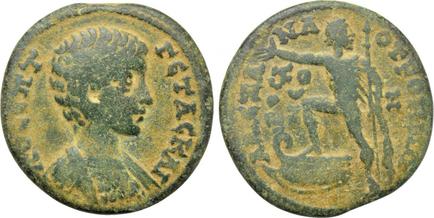
PHRYGIA. Otrus. Geta, as Caesar. 193-209 AD. 24mm Alexandros, magistrate. Obv: PO CEPT GETAC KAI, bare-headed and cuirassed bust right / ALEXAN-DR-OC AN-EO[...] OTPONW, Otreus embarking on prow of ship to left, right arm raised, head turned back, holding spear in left hand. Von Aulock, Phrygiens 832; SNG von Aulock 3906 (Author's collection)
Coins of Lykurgos
Lykurgos was the son of the king Eumenos. After the death of his father, his older brother Polydektes took the throne. Not much later, he also died and Lykurgos became king. The widow of his brother, an ambitious and unhesitating woman, offered him to marry her and kill her unborn child. Lykurgos, knowing her character and being afraid for the life of the child, pretended to accept her offer. He said to her to bear the child and he would disappear it, as soon as the child was born. But when the time came, he took the infant boy at the Agora, proclaimed him king of the Spartans and gave him the name Charilaos (Joy of the people).
Coins of Lakedaimon (Sparta)
The history of Lakonia and its chief city, Lakedaimon (Sparta), were closely interconnected. Sparta was renowned for its military prowess, as well as its austerity, both in lifestyle and in language, so much so that the “Laconic Phrase” was renowned even in Classical times. Settlement in Sparta stretched back to the Mycenean period and, according to Homer, it was ruled by Menelaus and his wife Helen. Beginning in the early Archaic period, two ruling houses, the Agiads and the Eurypontids, ruled Sparta jointly. Under the reforms of the mytho-historical Lykourgos in the early seventh century BC, the Spartan state underwent a significant restructuring along military lines. This new system, designed to build a strong army, required all men to train and live in common. Boys at the age of seven were sent to the agoge, where they received rigorous education and training. The Spartan citizenry was divided into three groups: the free citizens of Sparta; the perioikoi, those who lived outside of the city, free citizens who lacked civic rights; and the heilotes (helots), or slaves, most of whom were Messenian.
While the Spartans desired to remain apart from the other Greeks, they nevertheless did leave the Peloponnesus to assist them in their wars. The most famous example of this is the role of the 300 Spartans, under their king Leonidas, at Thermopylai. Also, at Plataiai in 479 BC, it was the Spartan hoplites who forever ended the hope of a Persian conquest. During the rest of the 5th century BC, Spartan competition with Athens for supremacy among the Greeks led to the Peloponnesian War (431-404 BC), which Sparta ultimately won. The rise of Macedon during the 4th century BC, and its successor kingdoms, weakened the power of Sparta, compelling it to become part of the Achaen League until 146 BC, when it became an ally of Rome.
While the Spartans desired to remain apart from the other Greeks, they nevertheless did leave the Peloponnesus to assist them in their wars. The most famous example of this is the role of the 300 Spartans, under their king Leonidas, at Thermopylai. Also, at Plataiai in 479 BC, it was the Spartan hoplites who forever ended the hope of a Persian conquest. During the rest of the 5th century BC, Spartan competition with Athens for supremacy among the Greeks led to the Peloponnesian War (431-404 BC), which Sparta ultimately won. The rise of Macedon during the 4th century BC, and its successor kingdoms, weakened the power of Sparta, compelling it to become part of the Achaen League until 146 BC, when it became an ally of Rome.
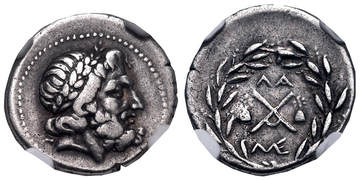
ACHAIA, Achaian League. Lakedaimon (Sparta). Circa 175-168 BC. AR Triobol – Hemidrachm (15.5mm, 2.39 g, 9h). Laureate head of Zeus right / Achaian League monogram; piloi of the Dioskouroi flanking, ΛA above, ME monogram below; all within wreath. Benner 1; BCD Peloponnesos 849; HGC 5, 642 ex. J. Cohen Collection; Ex Heritage 3038 (13 January 2015), lot 33093 (Author's collection)
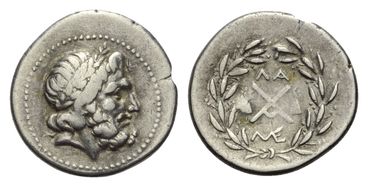
ACHAIA, Achaian League. Lakedaimon (Sparta). Circa 175-168 BC. AR Triobol – Hemidrachm (15.5mm, 2.36g). Laureate head of Zeus right / Achaian League monogram; piloi of the Dioskouroi flanking, ΛA above, ME monogram below; all within wreath. Benner 1; BCD Peloponnesos 849; HGC 5, 642 (Author's collection)
Coins of Persia under Xerxes I - Battle of Thermopylae against Sparta (480 B.C.)
The Battle of Thermopylae was waged between legendary Spartan king Leonides and Xerxes I of the Persian empire. The battle lasted just three days during the second Persian invasion of Greece. The earlier invasion was repelled by the Athenians during the famed Battle of Marathon (490 B.C.). Despite popular depictions, the 300 Spartan elite were likely joined by 7,000 Greek warriors against a Persian force of 100,000-150,000. Although the Greeks and Spartans lasted only seven days, it was enough to rally Greek reinforcements sufficient to repel Persian forces.

ACHAEMENID PERSIA. Time of Xerxes II-Artaxerxes II (5th-4th centuries BC). AV daric (14mm, 8.33 gm). Lydo-Milesian standard. Sardes, ca. 420-375 BC. Obv: Persian king or hero, wearing cidaris and candys, quiver over shoulder, in kneeling-running stance right, transverse spear in right hand, bow forward in left / Rev: Irregular incuse punch. Ref: Carradice Type IIIb, Group C. Sunrise 28. (formerly Author's collection)
Coins of Odysseus (Ulysses)
Odysseus (Ulysses) was the legendary King of Ithaca and hero of Homer’s epic poem, the Odyssey (and Iliad). He was husband to Penelope and father of Telemachus (son of Laertes and Anticlea).
|
|
|
Coins of Ordes/Orodes
The reverse represents the reconciliation between Apollo Smintheus and his priest, both enjoying the hospitality of the herdsman Orodes. According to the local legend (Iliad I. 39), Apollo, angered at his priest, sent a plague of mice to devastate the crops, but later repenting he appeared to Orodes the herdsman who hospitably received him, and Apollo promised to kill the mice with his arrows.
Coins of Philoctetes
Philoctetes, the son of King Poeas of Meliboea in Thessaly was a famed archer and possessed the bow and arrows of Hercules, but had been left by the Greek fleet in Lemnos because he had been bitten by a snake and his wound had a horrendous smell. Philoctetes was bitter, but was finally persuaded to join the Greeks.
|
|
|
King Priam

TROAS, Ilium. Commodus. AD 177-192. Æ (27mm, 10.64 g, 6h). Struck circa AD 180-182. Laureate, draped, and cuirassed bust right; c/m: helmeted head of Minerva right in oval incuse / King Priam seated right on throne, holding scepter. RPC IV online 2485; SNG von Aulock 7616 (image courtesy of CNG; ex. Bill Hearn collection)
Coins of Protesilaos
Protesilaos was a hero in the Iliad who was venerated in Thessaly and Thrace. Protesilaos was the son of Iphicles and the leader of the Phylaceans. Hyginus believed he was originally known as Iolaus, but was referred to as Protesilaos after being the first to die in Troy.
Protesilaos was one of the suitors of Helen. He brought forty ships with him to Troy, and was the first to land, the first man who dared to leap ashore when the Greek fleet touched the Troad, Pausanias recalled, quoting "the author of the epic called the Cypria. An oracle had prophesied that the first Greek to walk on the land after stepping off a ship in the Trojan War would be the first to die, and so, after killing four men, he was himself slain by Hector. After Protesilaos' death, his brother, Podarces, joined the war in his place.
Protesilaos was one of the suitors of Helen. He brought forty ships with him to Troy, and was the first to land, the first man who dared to leap ashore when the Greek fleet touched the Troad, Pausanias recalled, quoting "the author of the epic called the Cypria. An oracle had prophesied that the first Greek to walk on the land after stepping off a ship in the Trojan War would be the first to die, and so, after killing four men, he was himself slain by Hector. After Protesilaos' death, his brother, Podarces, joined the war in his place.
|
|
|
Coins of Scamander
Scamander (Skamandros) was a river god, son of Oceanus and Tethys (according to Hesiod). Scamander is also thought of as the river god, son of Zeus. Via Idaea, he fathered King Teucer, Scamander fought on the side of the Trojans during the Trojan War (Iliad XX, 73,74 XXI). Scamander was also said to have fought against Achilles, who was only saved due to the intervention of Hera, Athena ad Hephaestus. In this context, he is the personification of the Scamander River that flowed from Mount Ida across the plain beneath the city of Troy, joining the Hellespont north of the city. The Achaeans, according to Homer, had set up their camp near its mouth, and their battles with the Trojans were fought on the plain of Scamander.
According to Homer, he was called Xanthos by gods and Scamander by men, which might indicate that the former name refers to the god and the latter one to the river itself. In Iliad XXI he tried to drown Achilles after being mocked by him, but was stopped by Hera and Hephaestus.
According to Homer, he was called Xanthos by gods and Scamander by men, which might indicate that the former name refers to the god and the latter one to the river itself. In Iliad XXI he tried to drown Achilles after being mocked by him, but was stopped by Hera and Hephaestus.
|
|
|
Coins of Telephus
Telephus was the son of Hercules and Auge, daughter of King Aleus of Tegea. Aleus received an oracle that predicted his grandson, Telephus, would kill his uncles. Fearing for his sons, Aleus exposed the infant Telephus on Mt. Parthenion, hoping that, through the child's death, the oracle could be avoided. Miraculously, however, Telephus was saved and suckled by a hind.
Telephus later became king of the Mysians and founder of the city of Pergamon. During the Trojan War he was wounded in a fight with Achilles. When this wound would not heal, Telephus learned through an oracle that he could only be healed by the one who had wounded him. When Achilles refused, Telephus seized Orestes, the son of Agamemnon, leader of the Greeks, threatening to kill the boy unless Achilles agreed to help. Odysseus, however, interpreting the oracle in his own way, pointed out that, as it had been the spear which was the source of the wound, so too it must be the source of the healing. Scrapings from the spear were applied to Telephus' wound, and it was healed.
Telephus later became king of the Mysians and founder of the city of Pergamon. During the Trojan War he was wounded in a fight with Achilles. When this wound would not heal, Telephus learned through an oracle that he could only be healed by the one who had wounded him. When Achilles refused, Telephus seized Orestes, the son of Agamemnon, leader of the Greeks, threatening to kill the boy unless Achilles agreed to help. Odysseus, however, interpreting the oracle in his own way, pointed out that, as it had been the spear which was the source of the wound, so too it must be the source of the healing. Scrapings from the spear were applied to Telephus' wound, and it was healed.
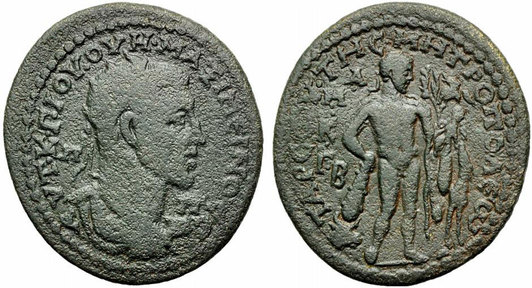
CILICIA, Tarsus. Maximinus I. AD 235-238. Æ (37mm, 24.27g, 12h). Radiate, draped, and cuirassed bust right, seen from behind, ΑΥΤ Κ Γ ΙΟΥ ΟΥΗ ΜΑΞΙΜΕΙΝΟϹ (ϹΕ)(Β) Π Π / Herakles standing right, holding club resting on bull’s head, lion skin, and the infant Telephus, who leans forward to pet a deer; tree with birds in background, ΤΑΡϹΟΥ (ΤΗϹ) ΜΗΤΡΟΠΟΛ(Εω)(Ϲ) Α Μ Κ Γ Β. RPC VI Online 7107.14 this coin); SNG France 1586, 1613, Levante 1098, Levante S1 278; RPC VI, 7107 (this coin imaged); ex ACRoma 4, Dec. 2011, #279 (Author's collection)

CILICIA, Tarsus. Maximinus I. AD 235-238. Æ (36mm, 22.36 g, 12h). Radiate, draped, and cuirassed bust right, seen from behind / Herakles standing right, holding club resting on bull’s head, lion skin, and the infant Telephus, who leans forward to pet a deer; tree with birds in background. RPC VI Online 7107.18 = SNG Levante 1098 (this coin); SNG BN 1613. ex. CNG 571, lot 458 (Sept 2024); CNG 66, lot 1198 (May 2004) Author's collection
Temple of Apollo Smintheus
Apollo Smintheus Temple is located in Gülpynar County in Western Turkey. The area is rich in water sources and supplied by underwater springs. The richness of water near the temple during the Hellenistic age is likely connected to the belief that Apollo required water in order to see the future. Based on it's architecture, scholars believe the temple was constructed during the Hellenistic-period (330-30 BC). The temple of Apollo Smintheus contains a number of reliefs describing some of scenes from Homer's Iliad. Based on the temple's remains, the temple had eight columns in the front and rear with 14 columns along the sides. Three different kinds of stone were used for the temple's construction to include volcanic tufa for its foundation, basalt-andesite stone was used to cover the outside, and the temple steps and internal components were made of marble. The holy statue, which is pictured on the coin below from Alexandria (Troas), images Apollo Smintheus holding a mouse (an image central to its mythology).
Coins imaging the City of Troy
The remarkable and apparently unpublished reverse type belongs to a thematic group of coins struck at Ilium under Marcus Aurelius depicting scenes related to the mythological history of Troy and its relationship with Rome. Here we have a depiction of the gods Poseidon (on the left) and Apollo (on the right) tasked with erecting the fortification walls of Troy for king Laomedon. Zeus had forced the two deities to serve the Trojan king as day laborers in punishment for a failed revolt against his authority. They built magnificent walls for the new city, but upon completion Laomedon refused to pay them their promised wages, thereby calling down a curse on Troy that ended in its destruction at the end of the Trojan War of Homeric epic. On the coin, Apollo, indicated in part by the laurel branch that he carries, rests his foot on a large stone block (indicated by very faint linear outline) while holding out what appears to be a brick. Poseidon, his coworker, is identified by his trident and reaches toward the brick, apparently in order to apply the mortar. He seems to hold a tool for this purpose, but it is difficult to be certain. In the background the walls of Troy and its main gate rise majestically. It is tempting to think that this reverse type may reflect some lost Hellenistic painting, for similar iconographic elements also appear in a fresco of the building of Troy found in the House of Siricus in Pompeii.

